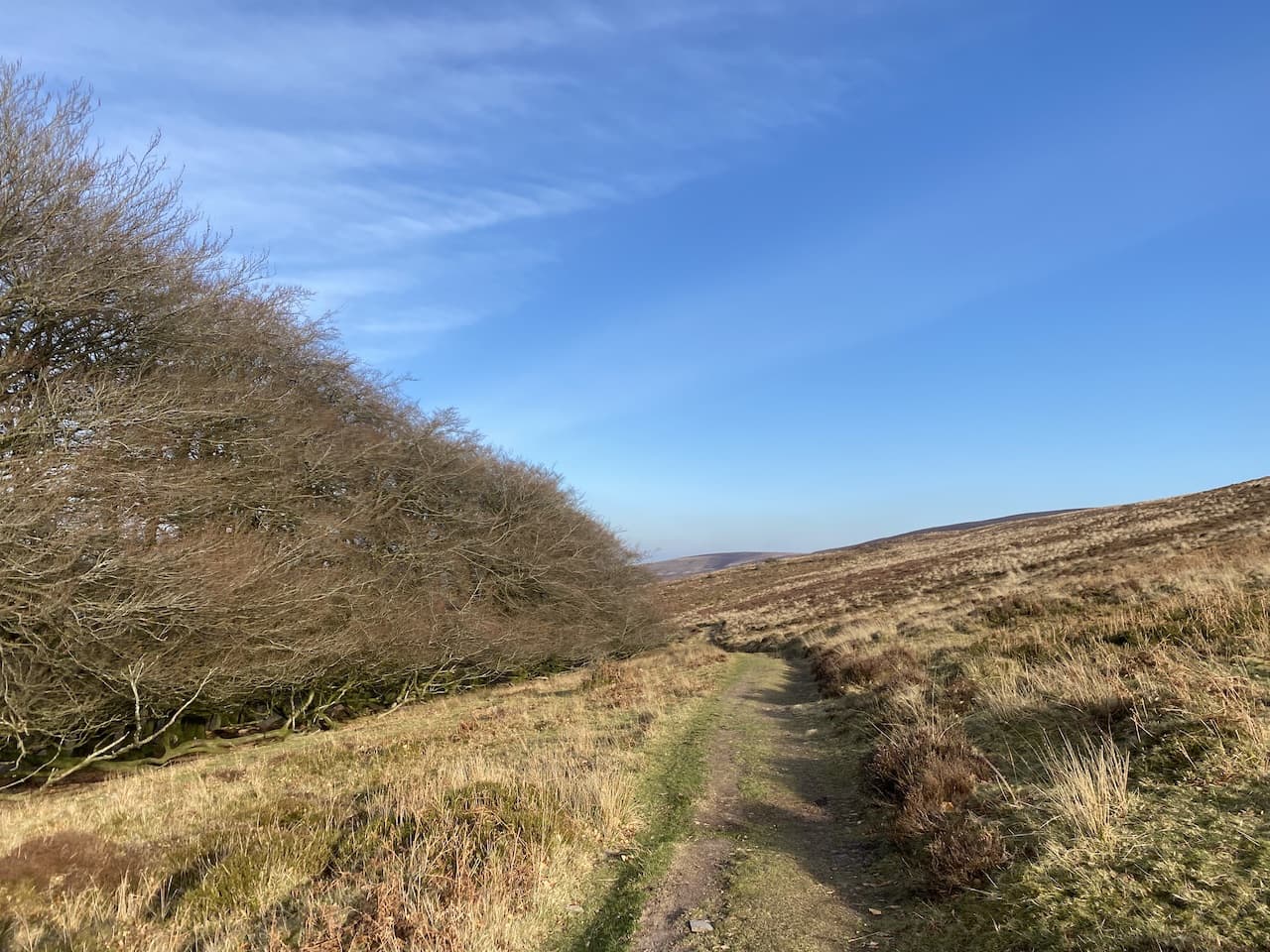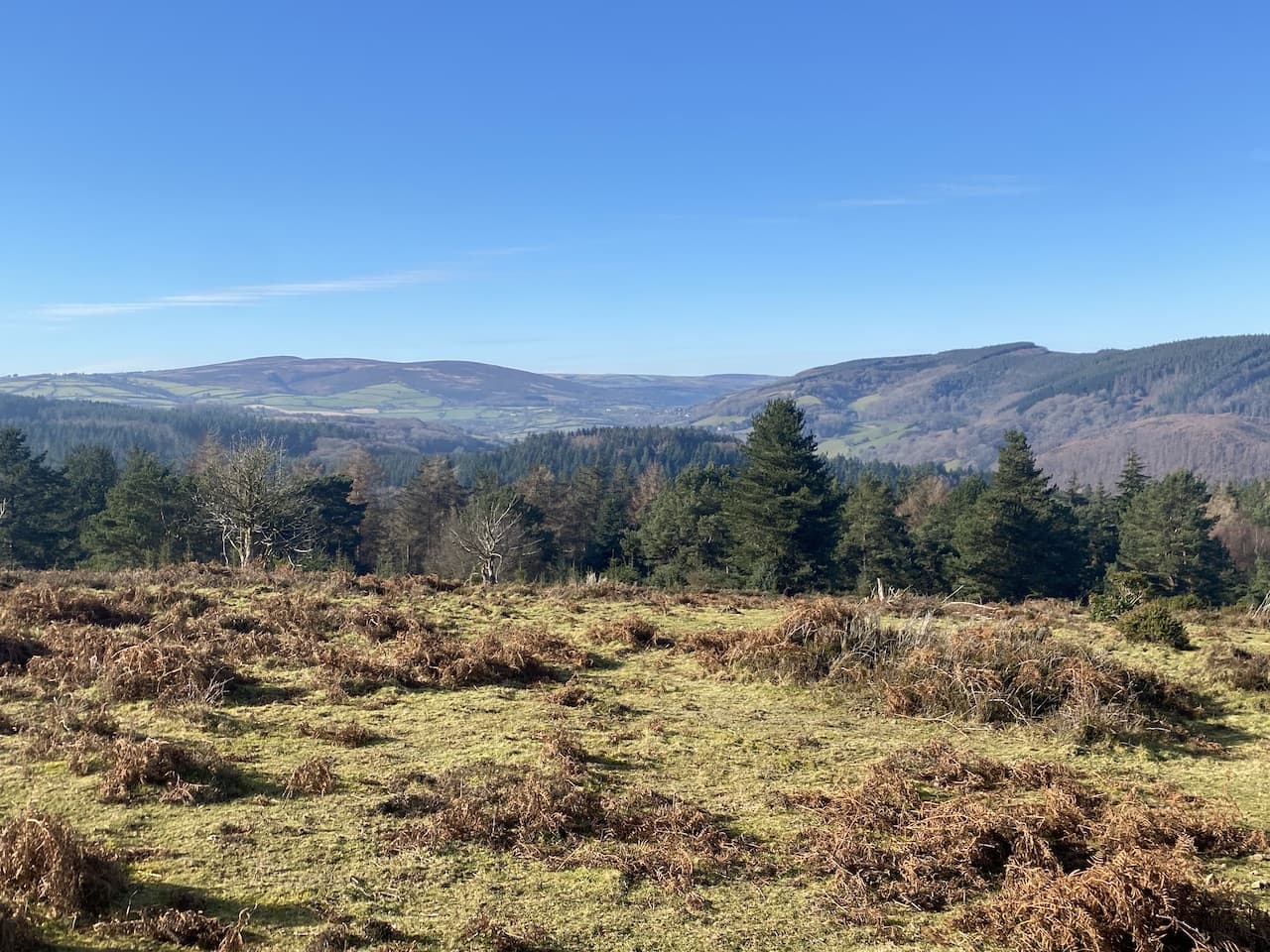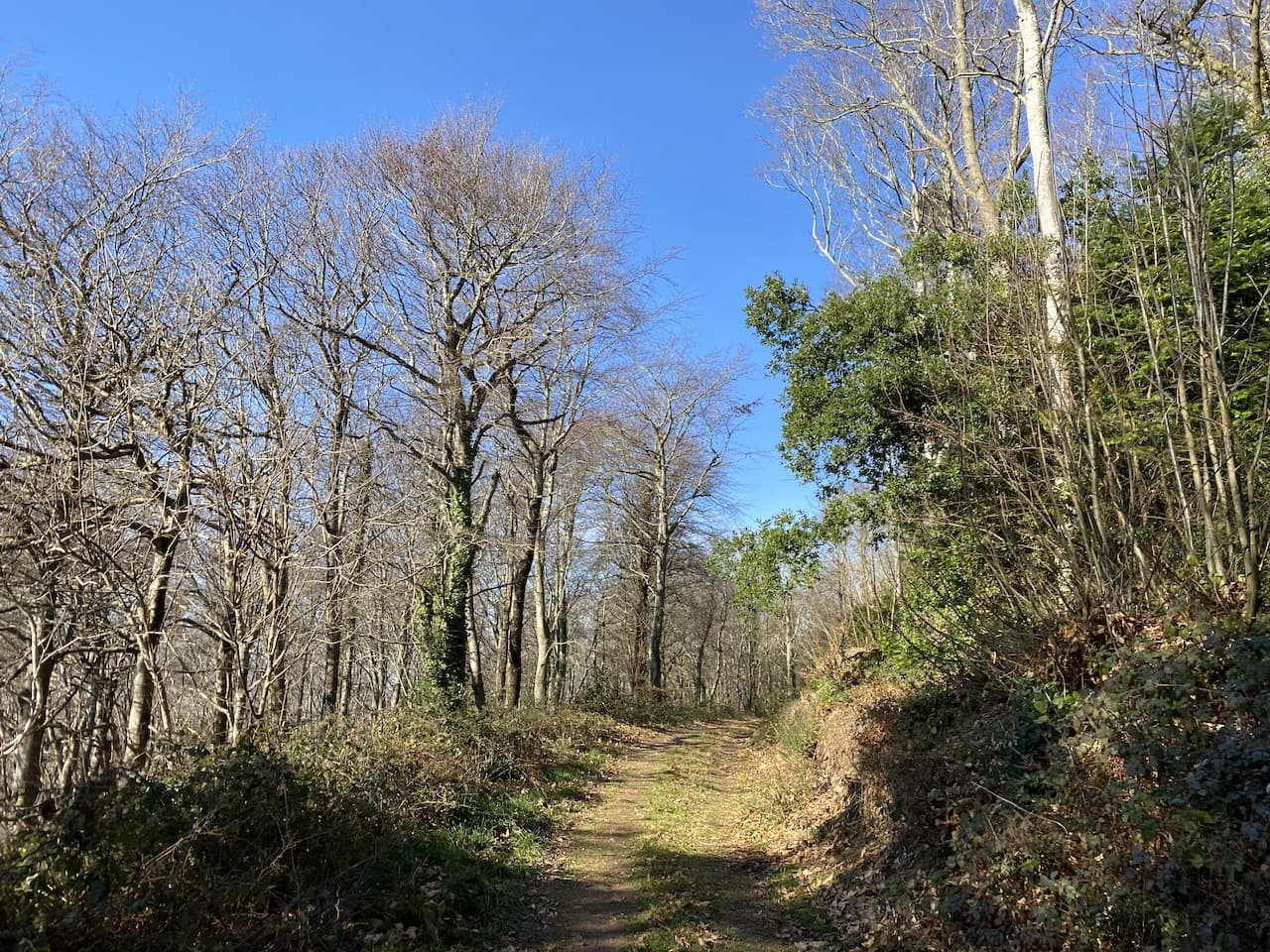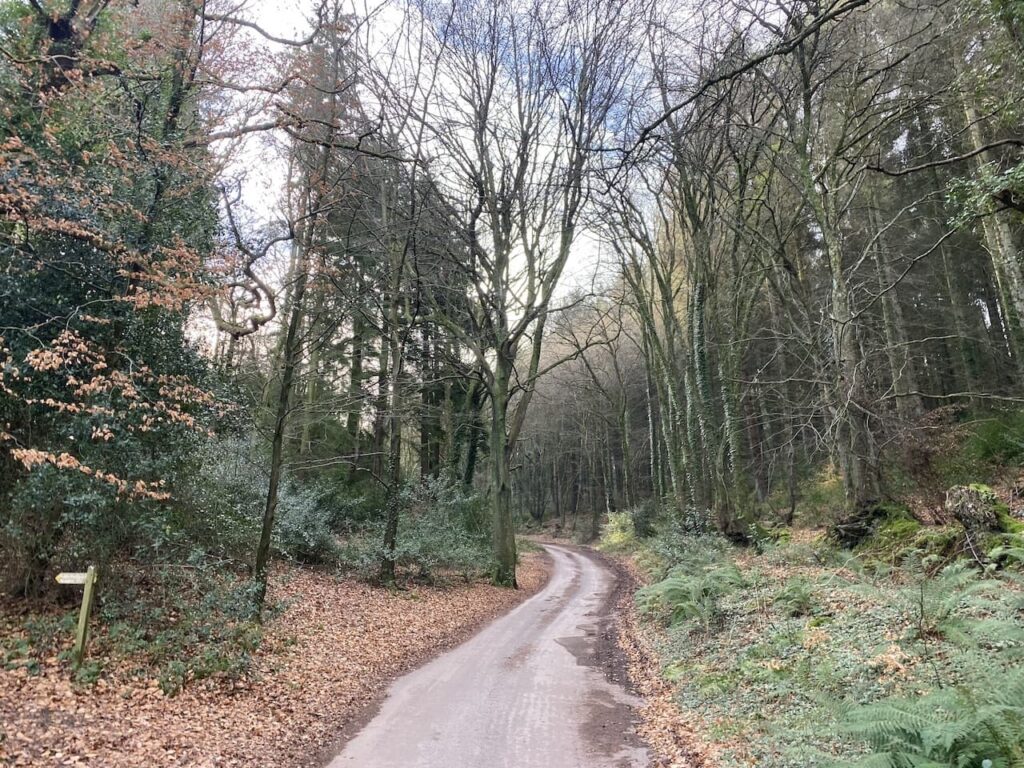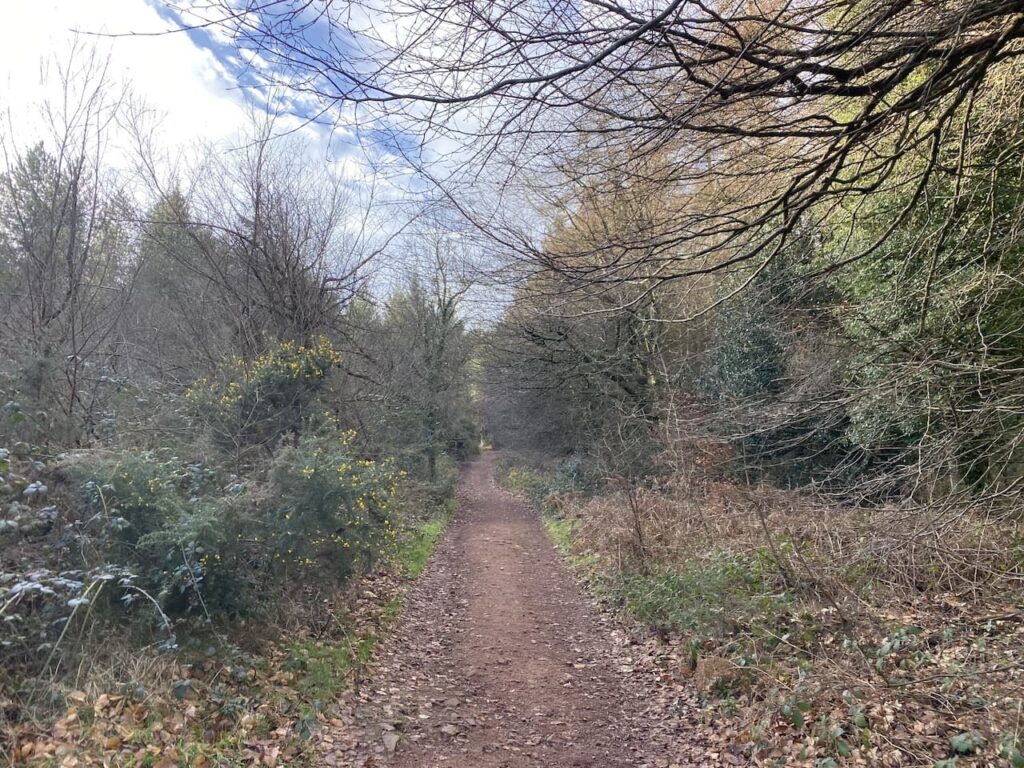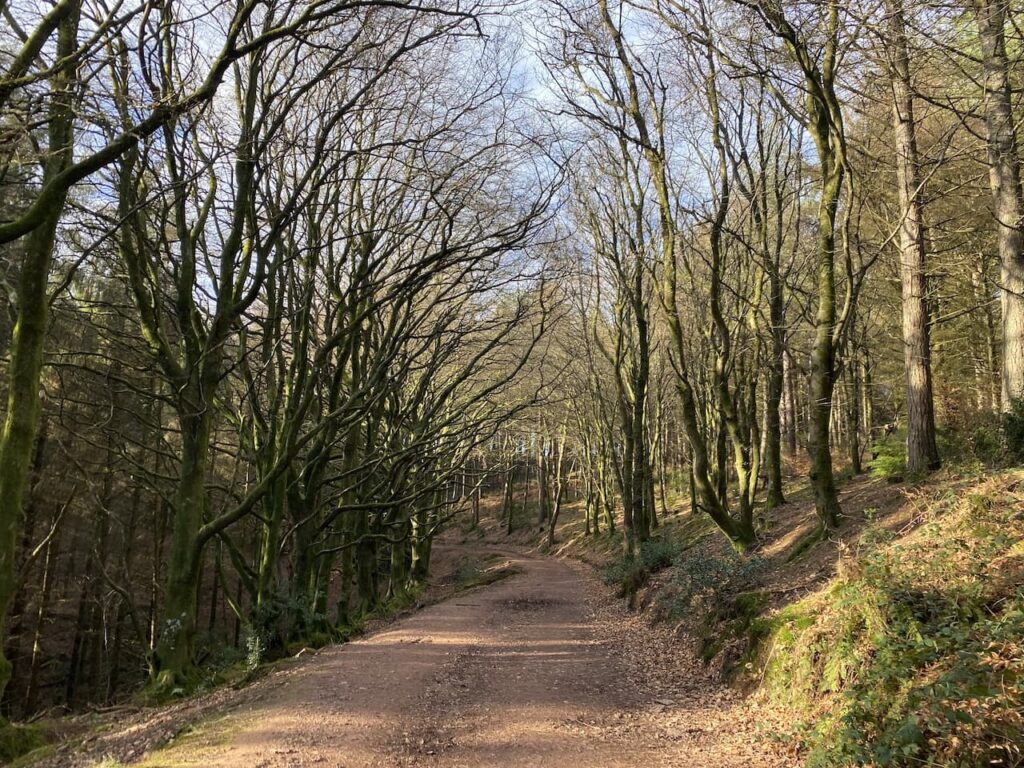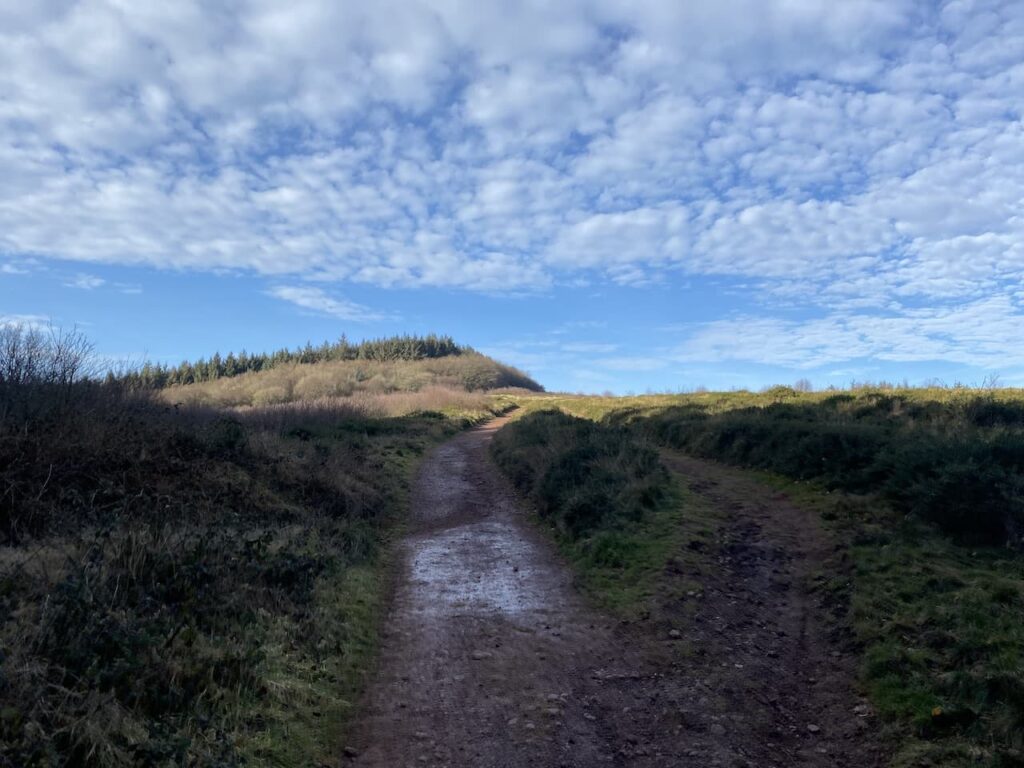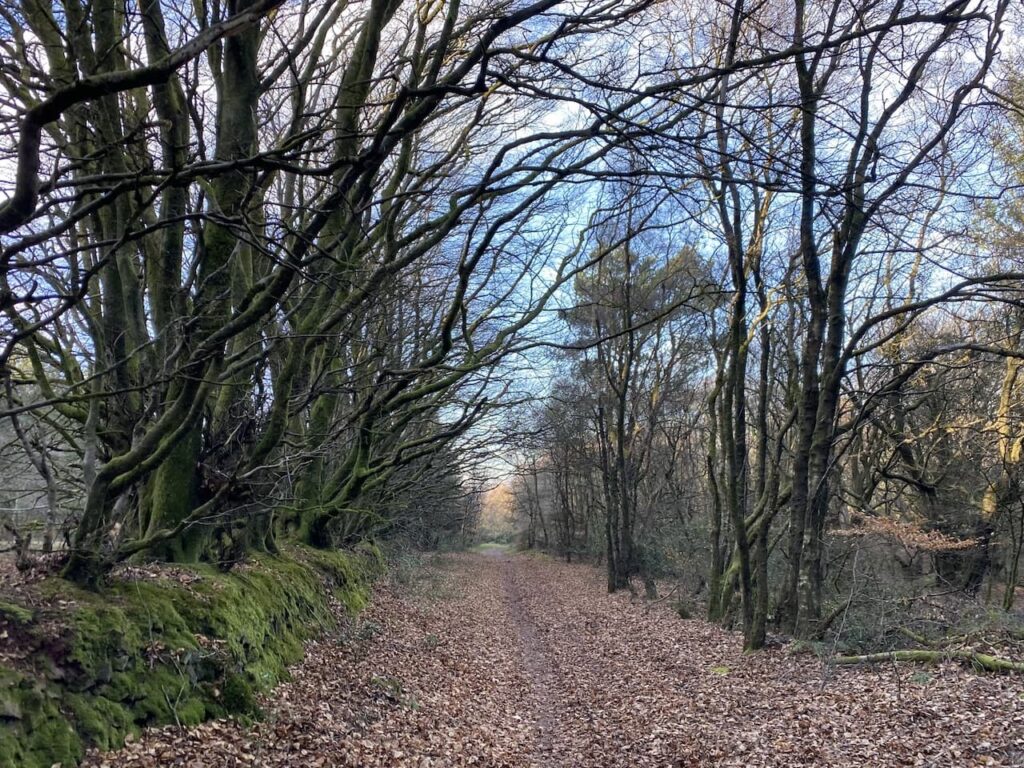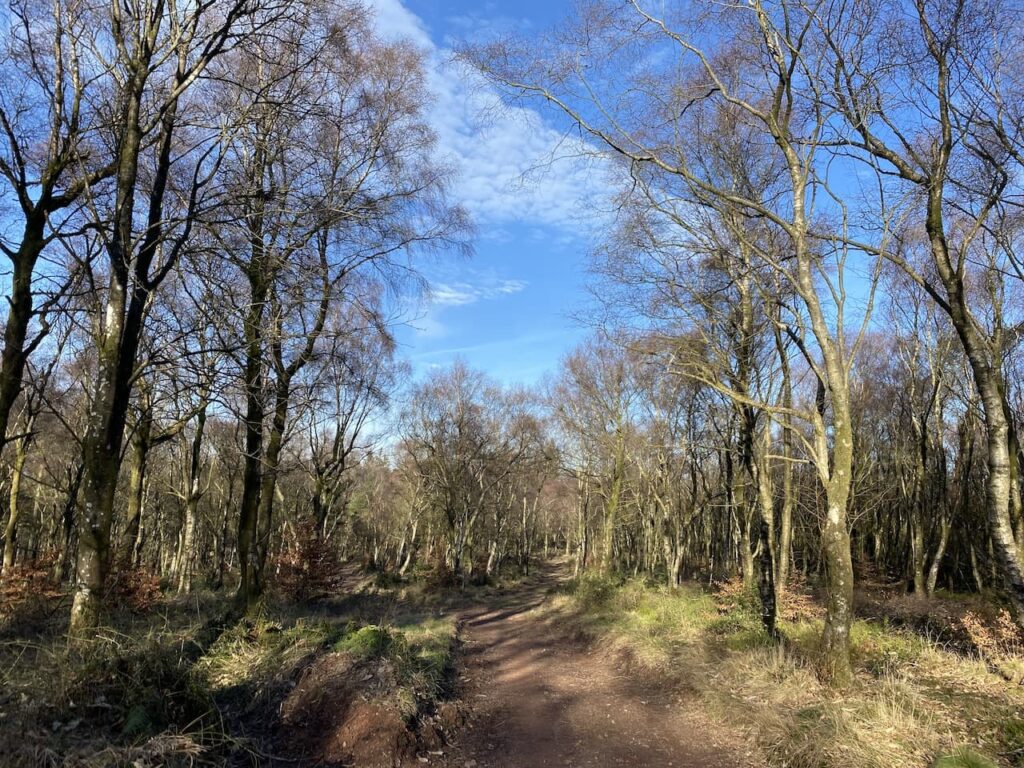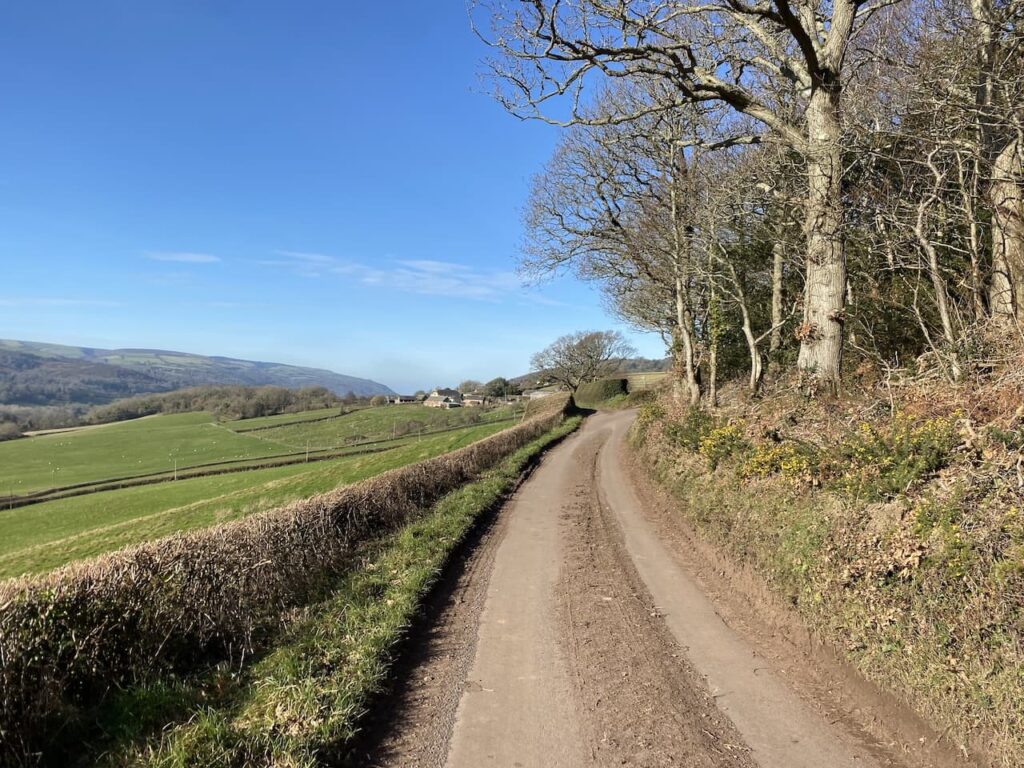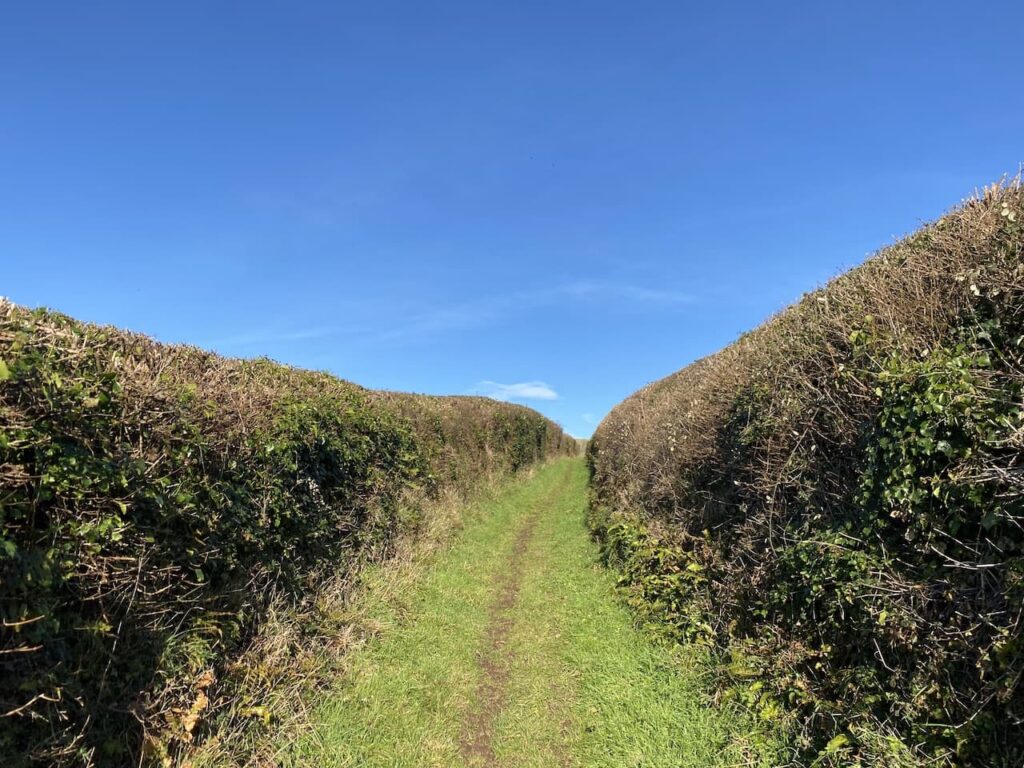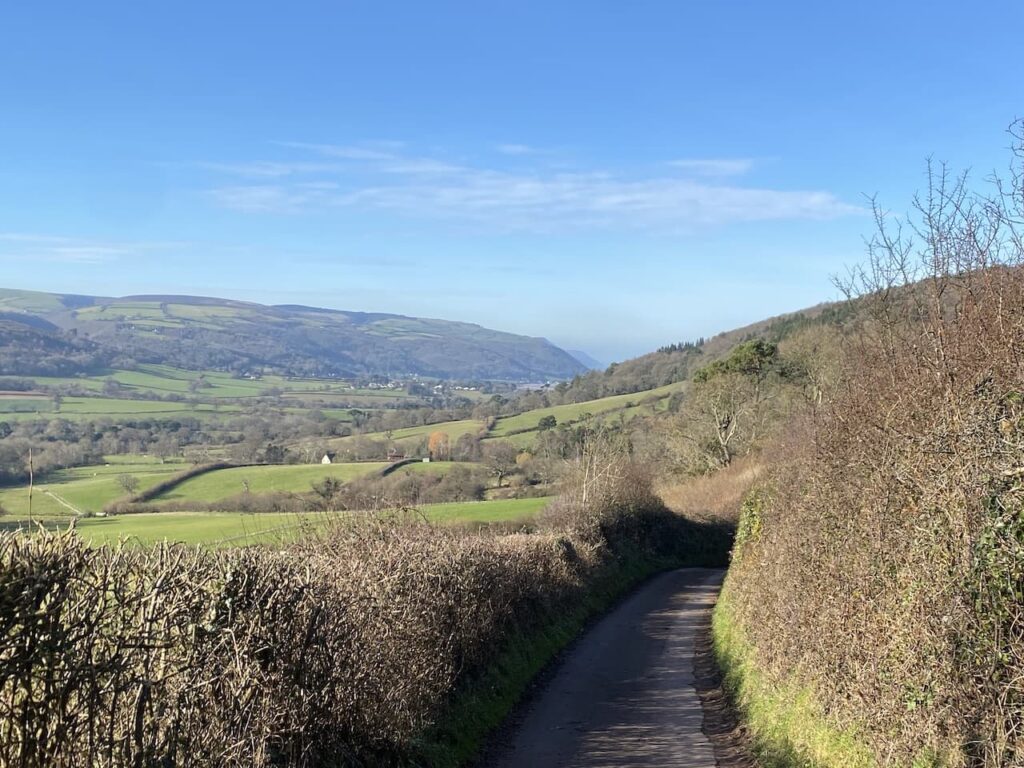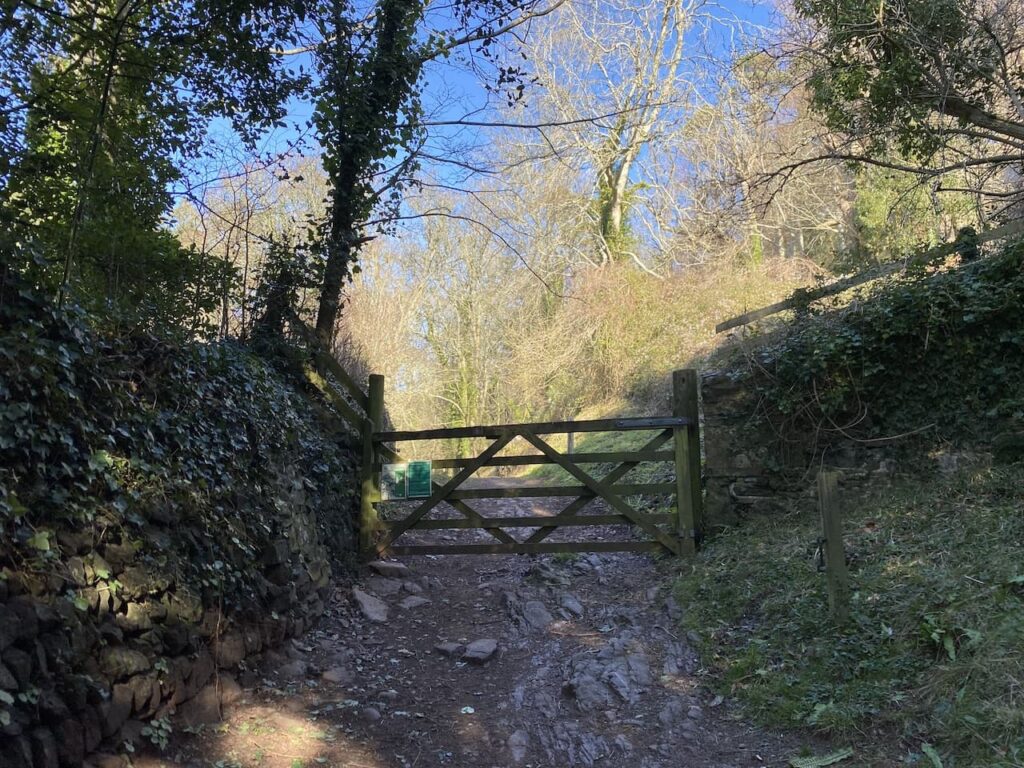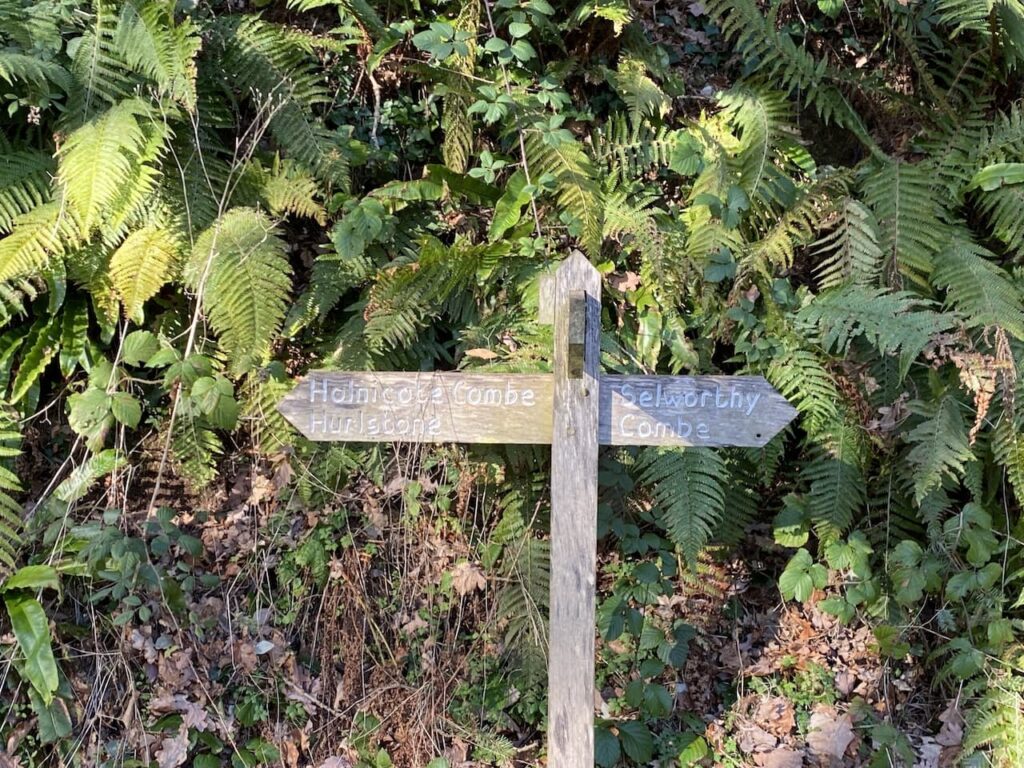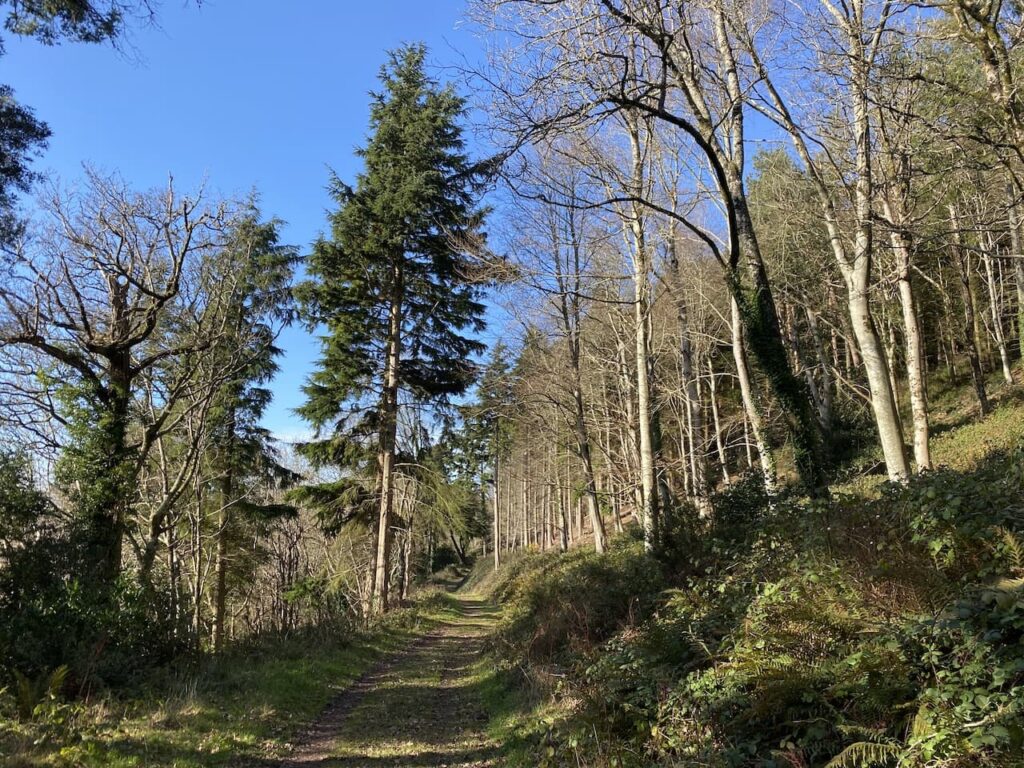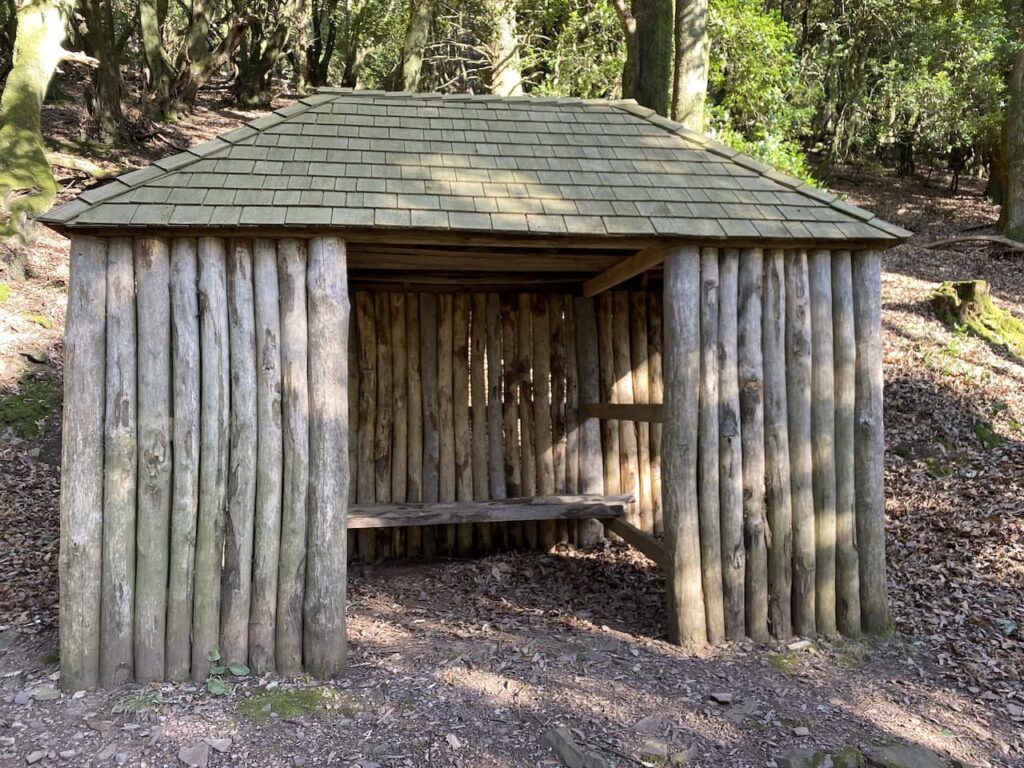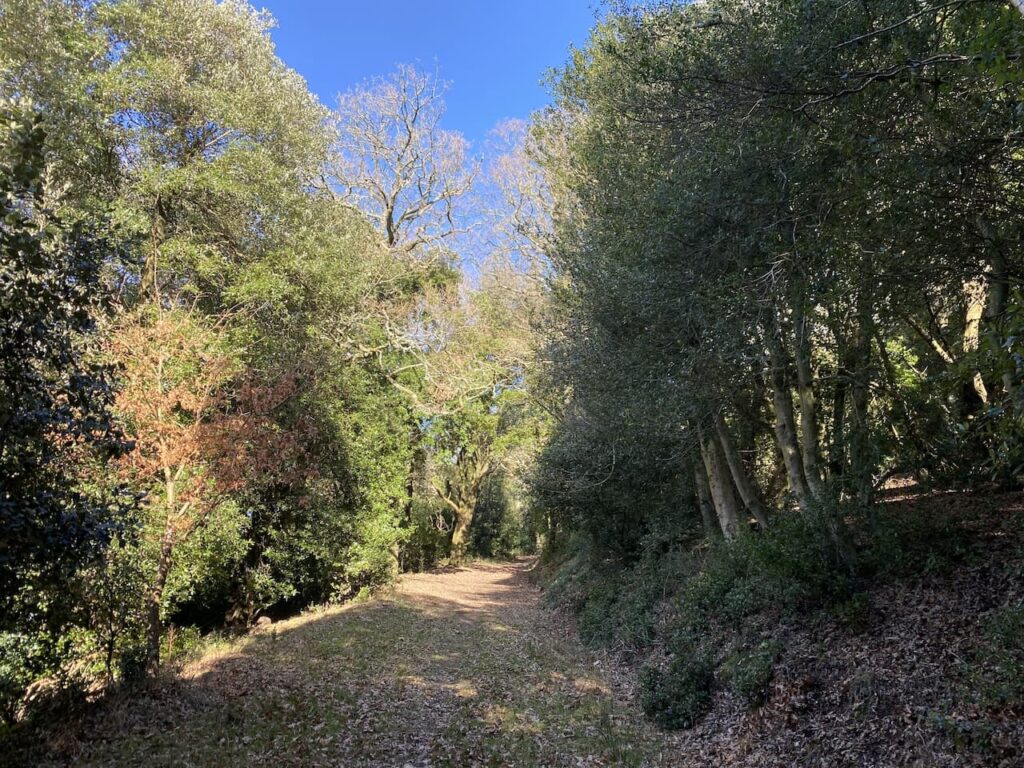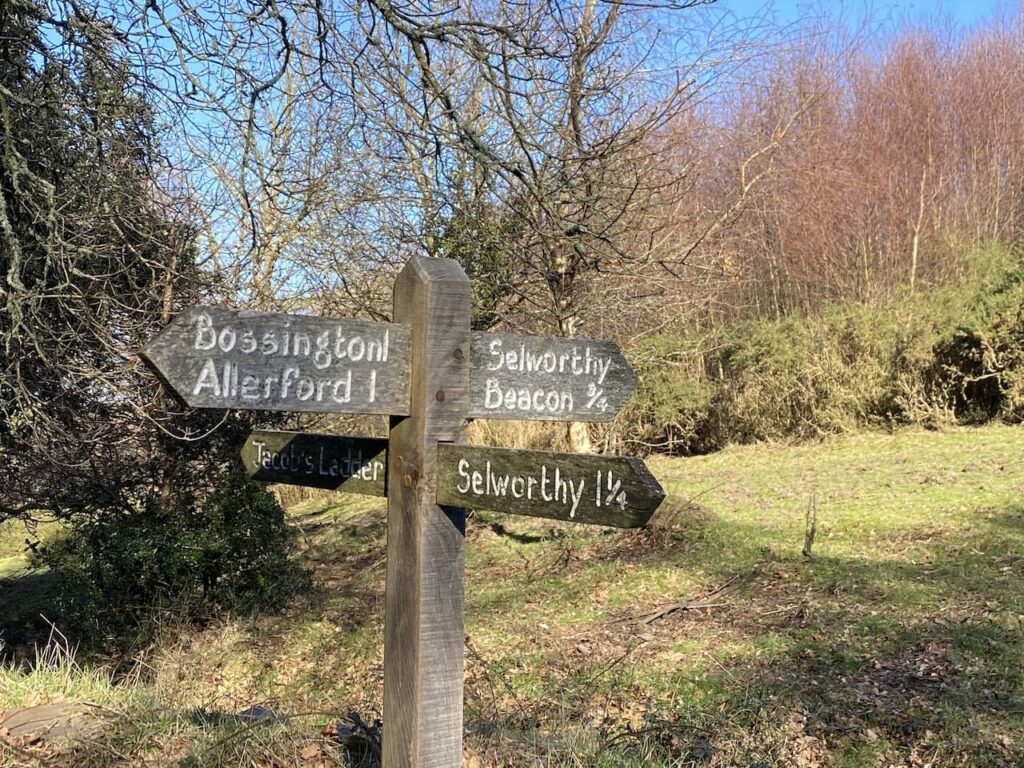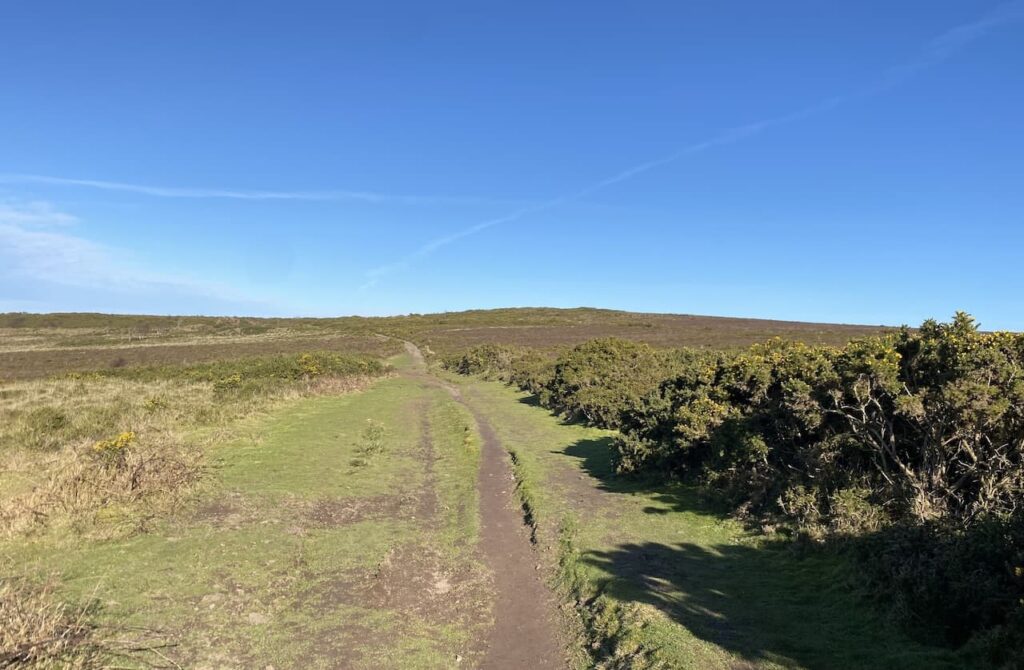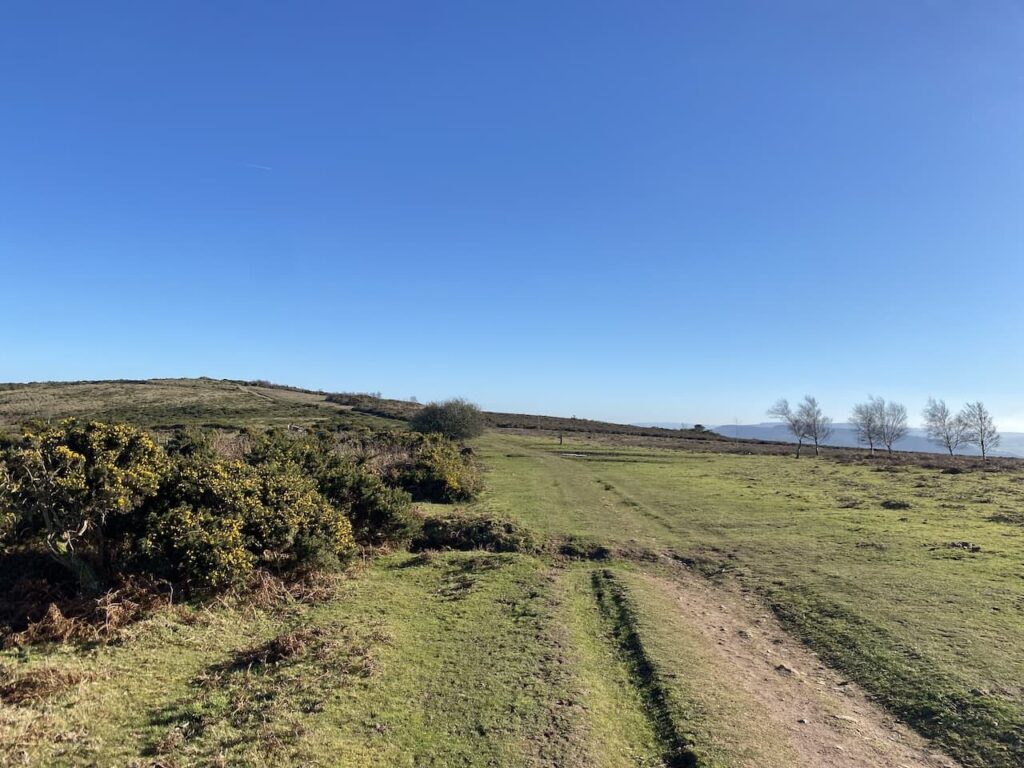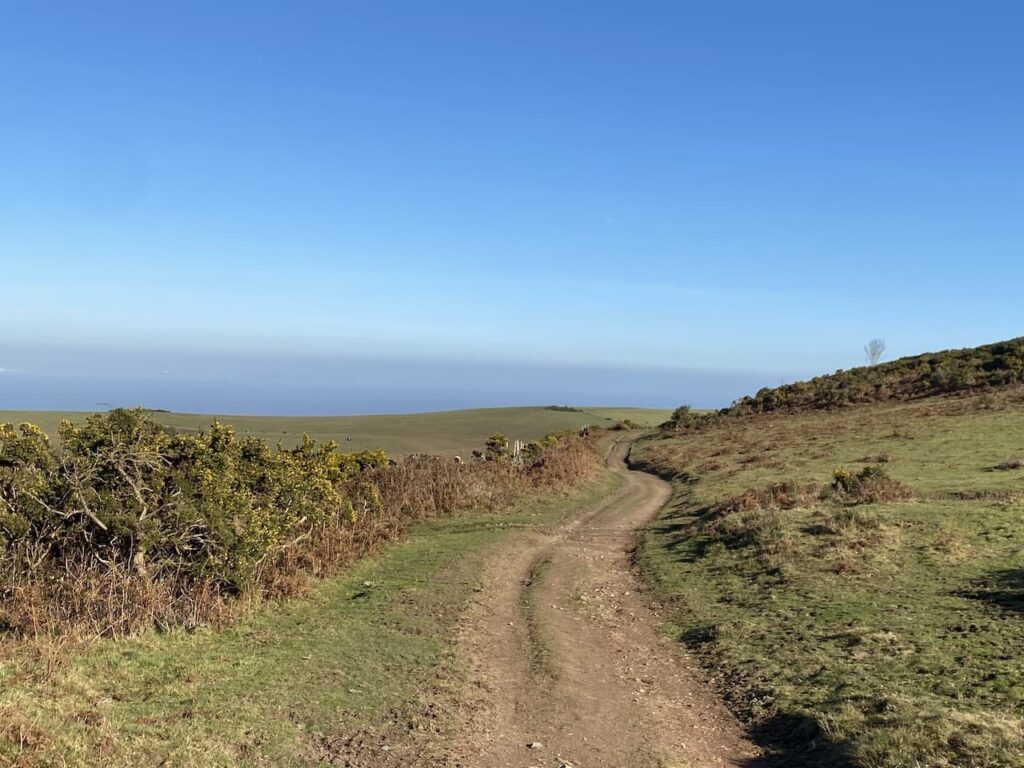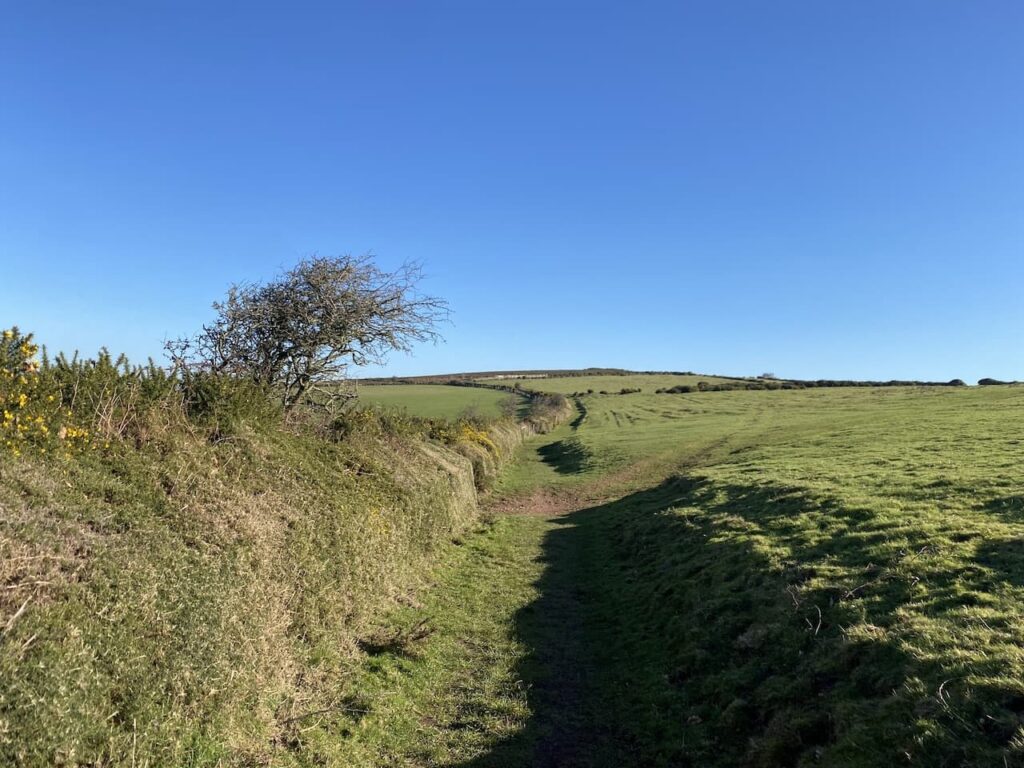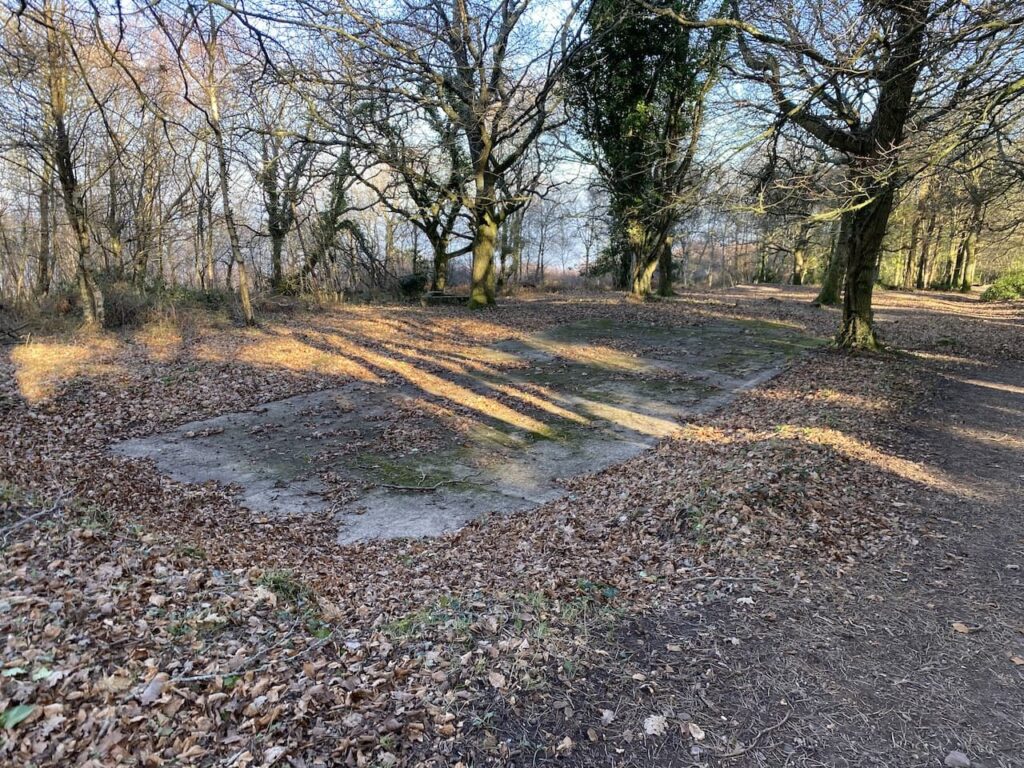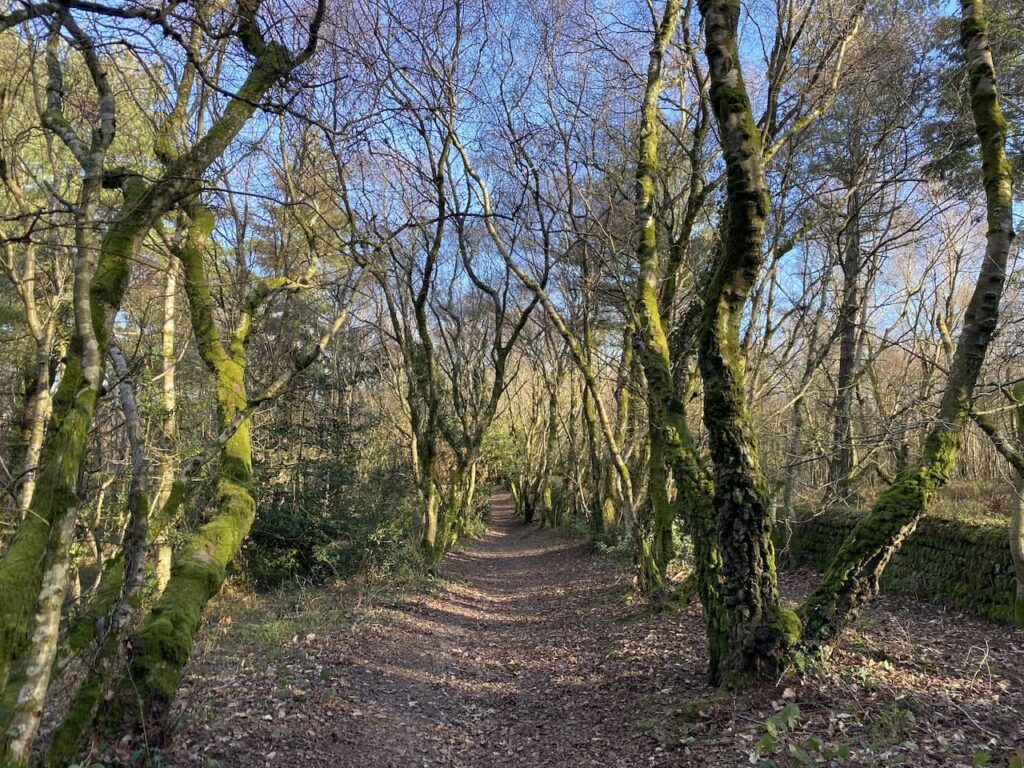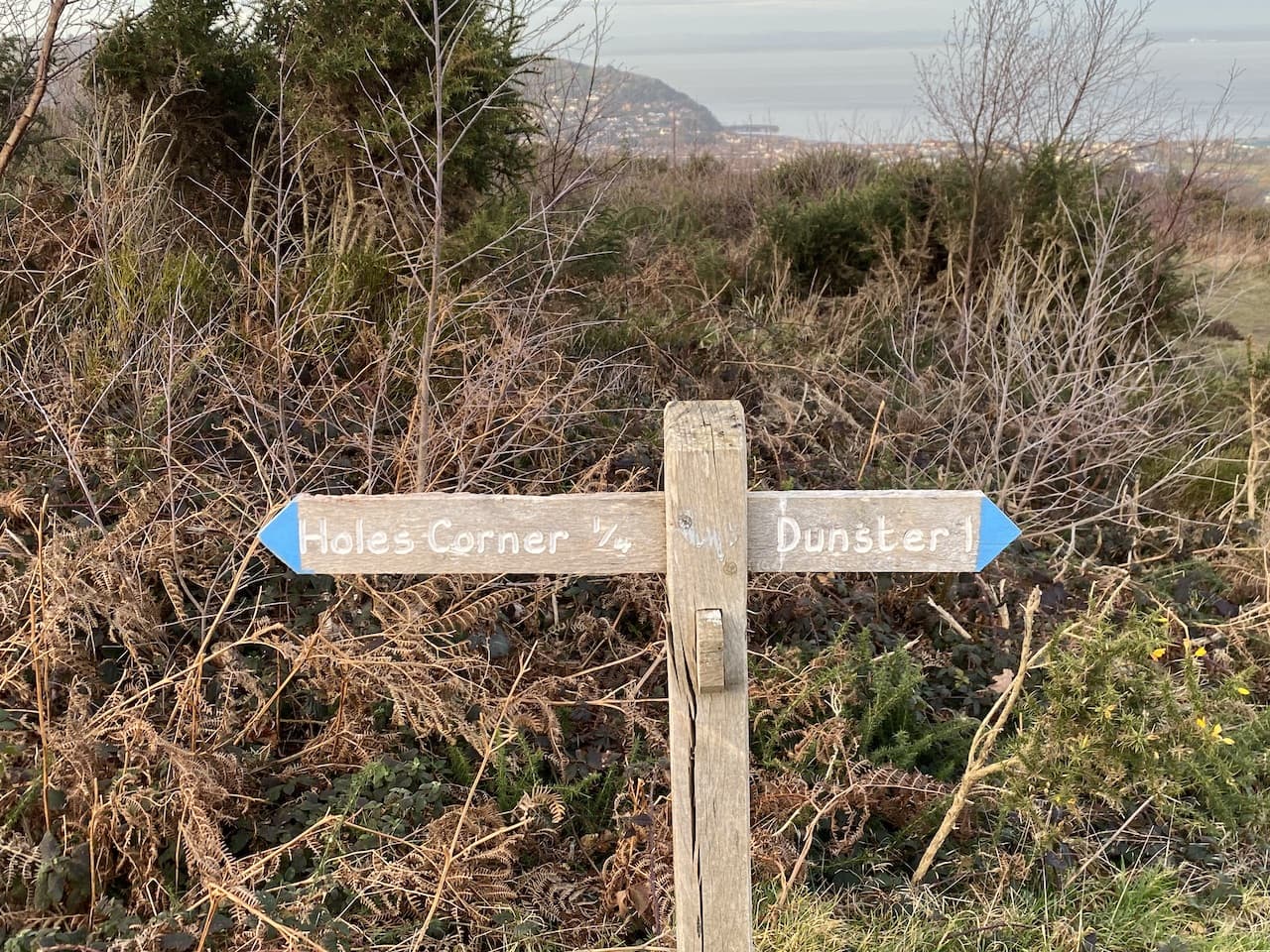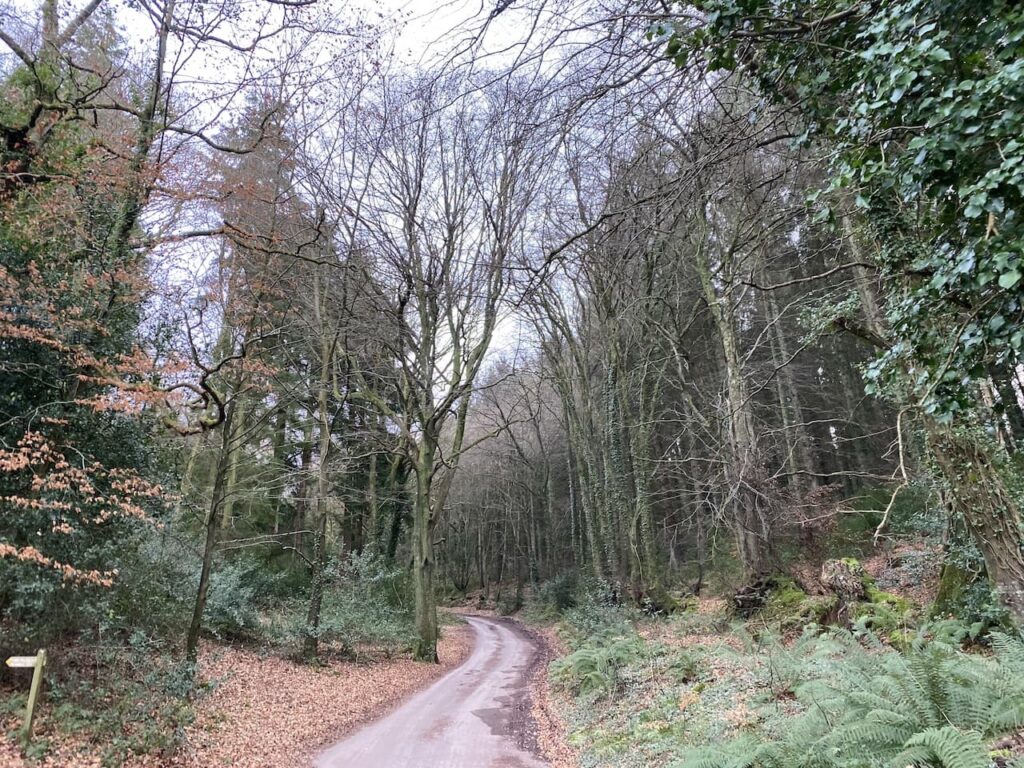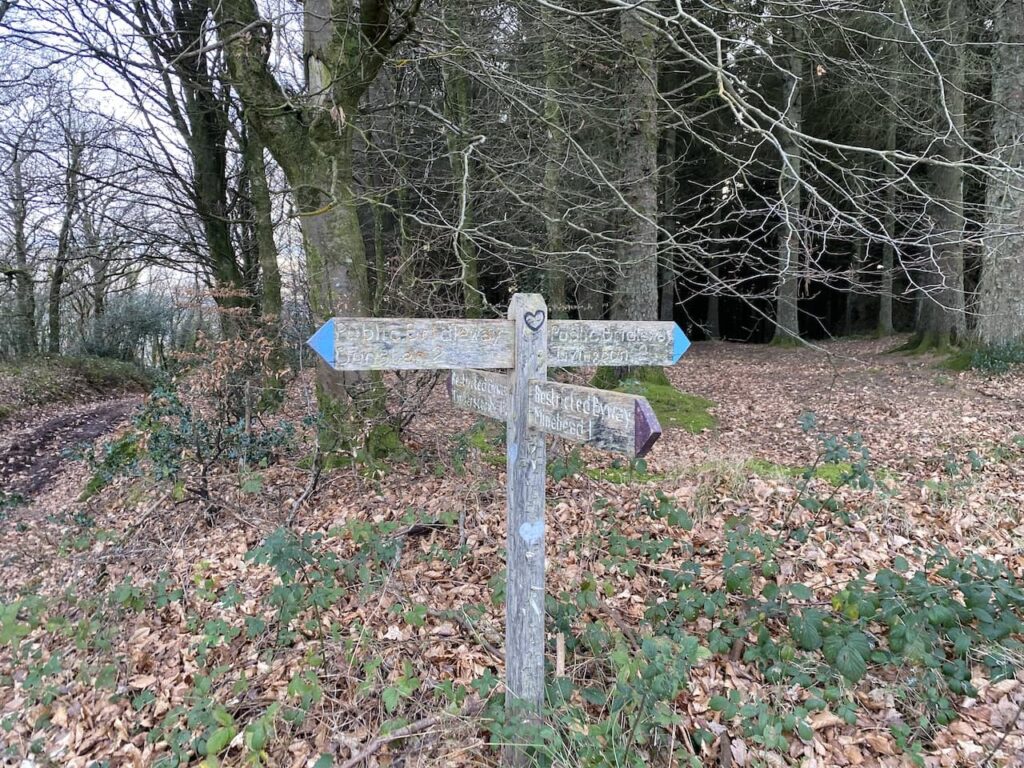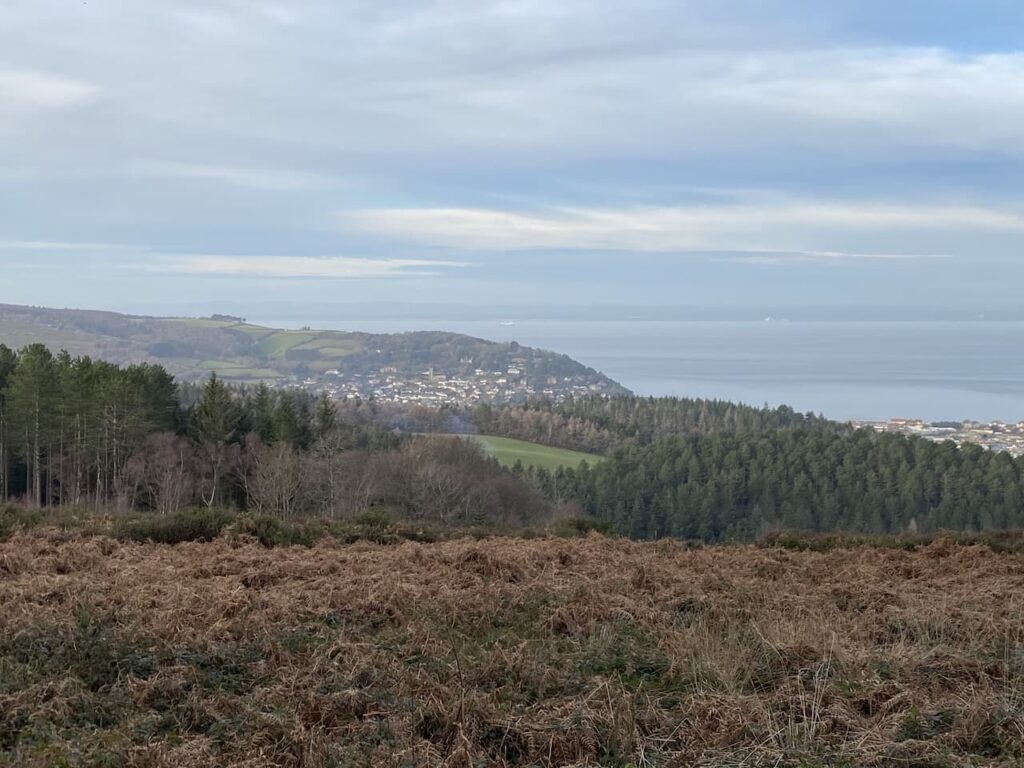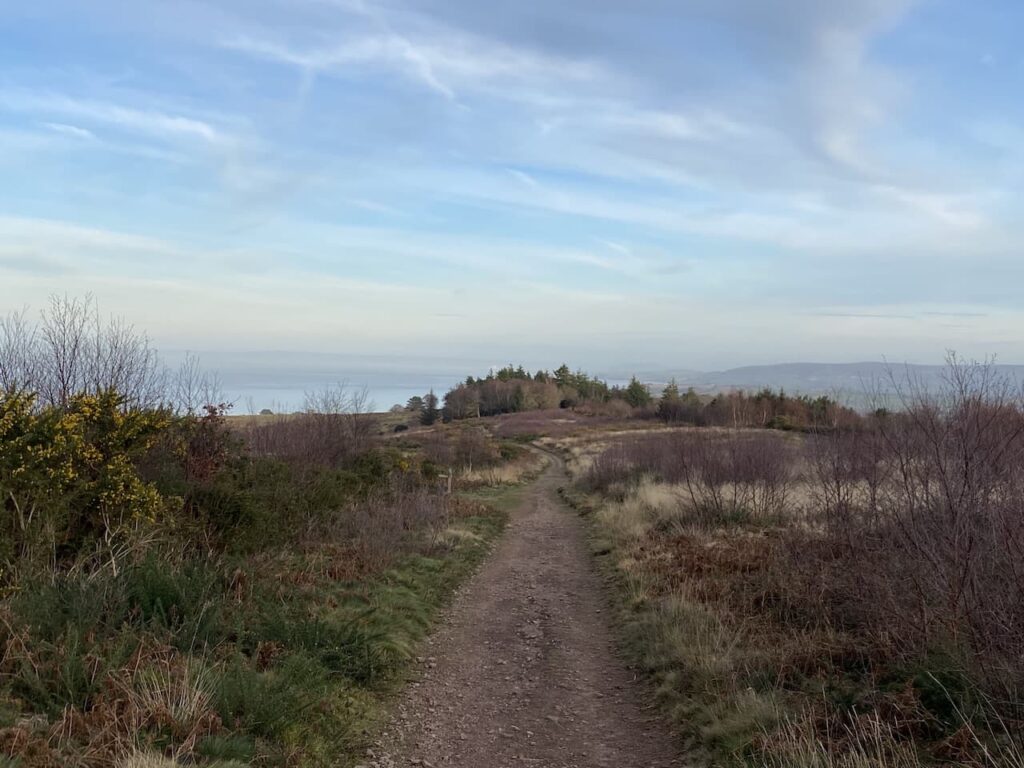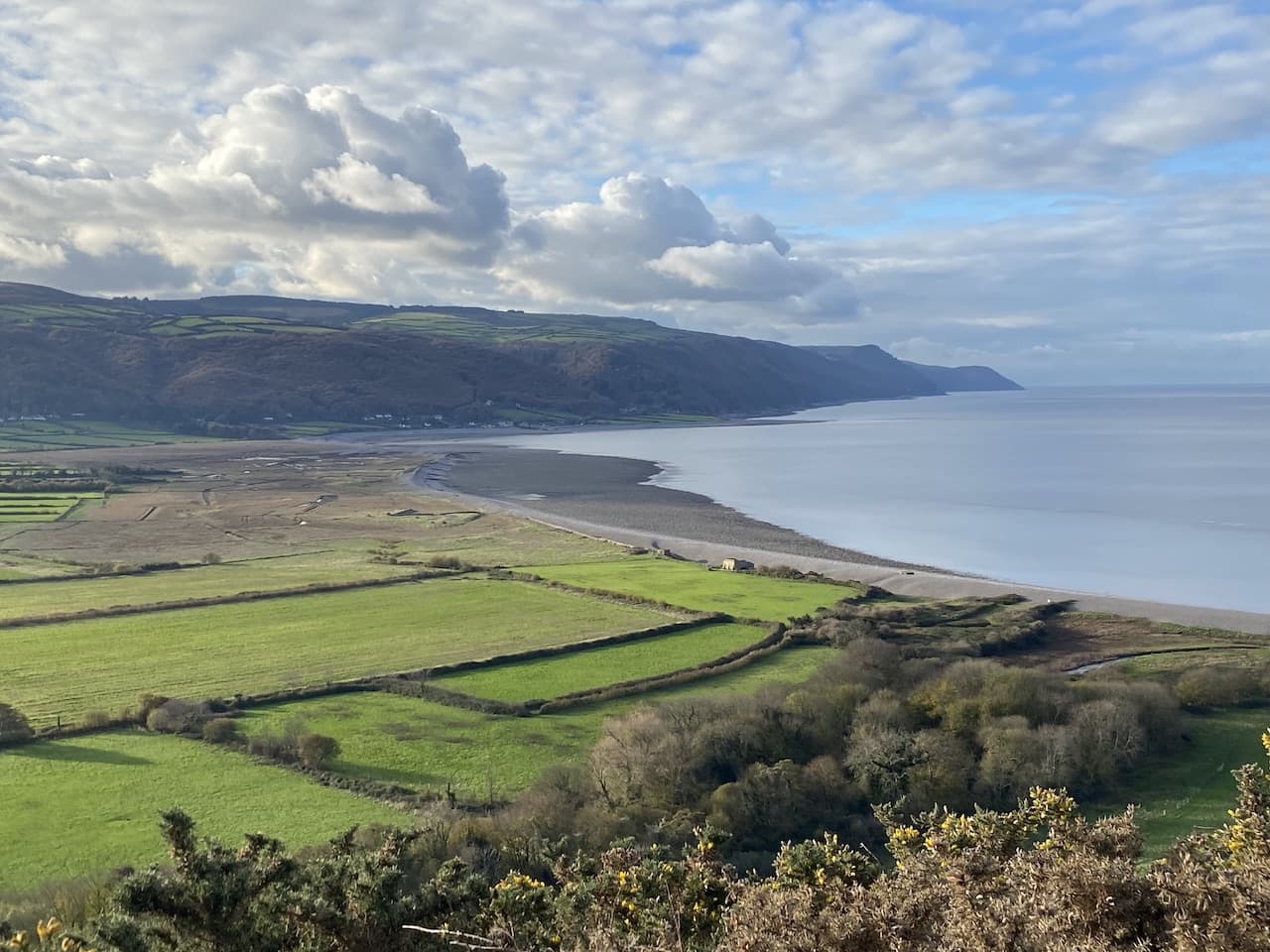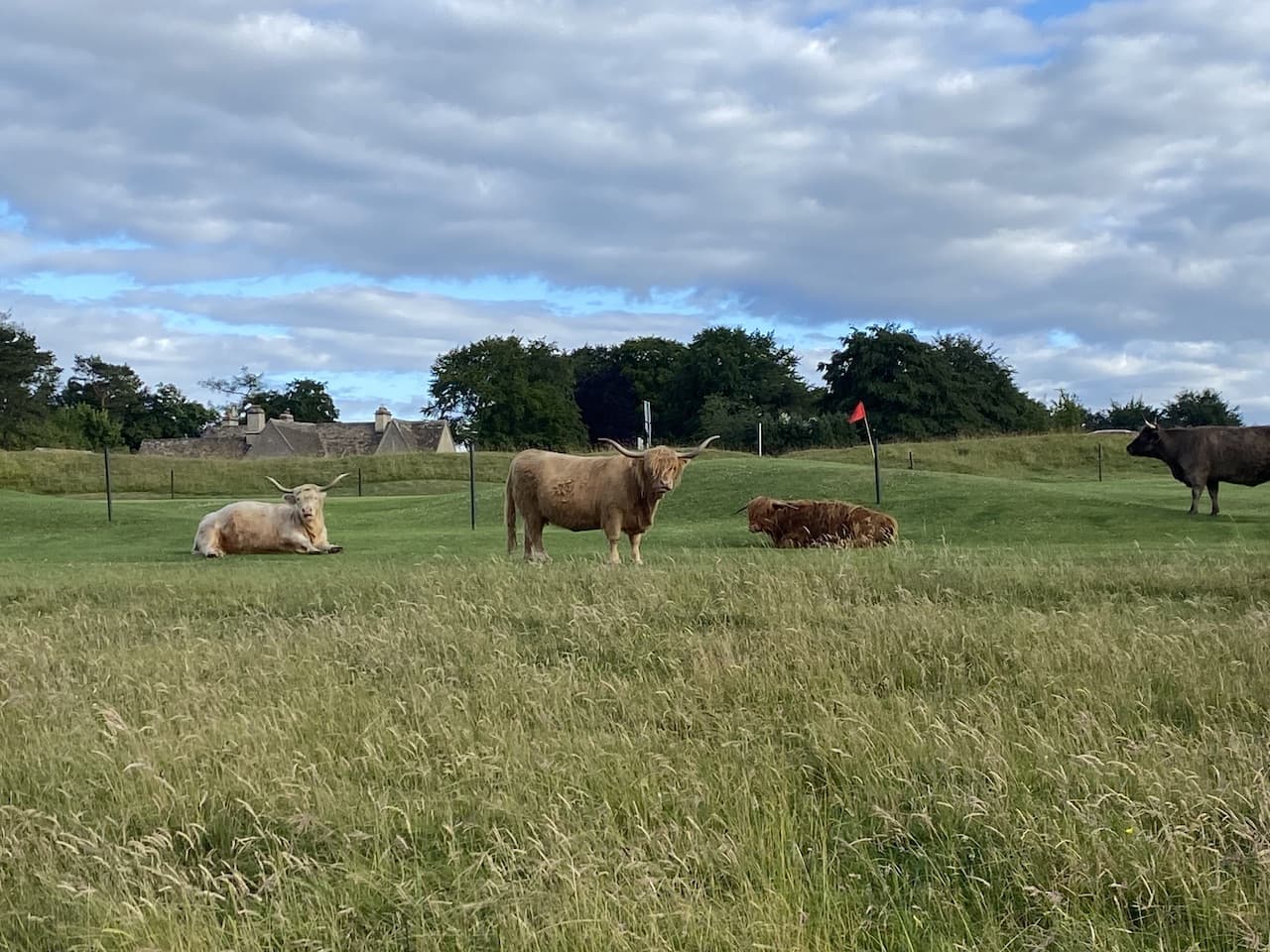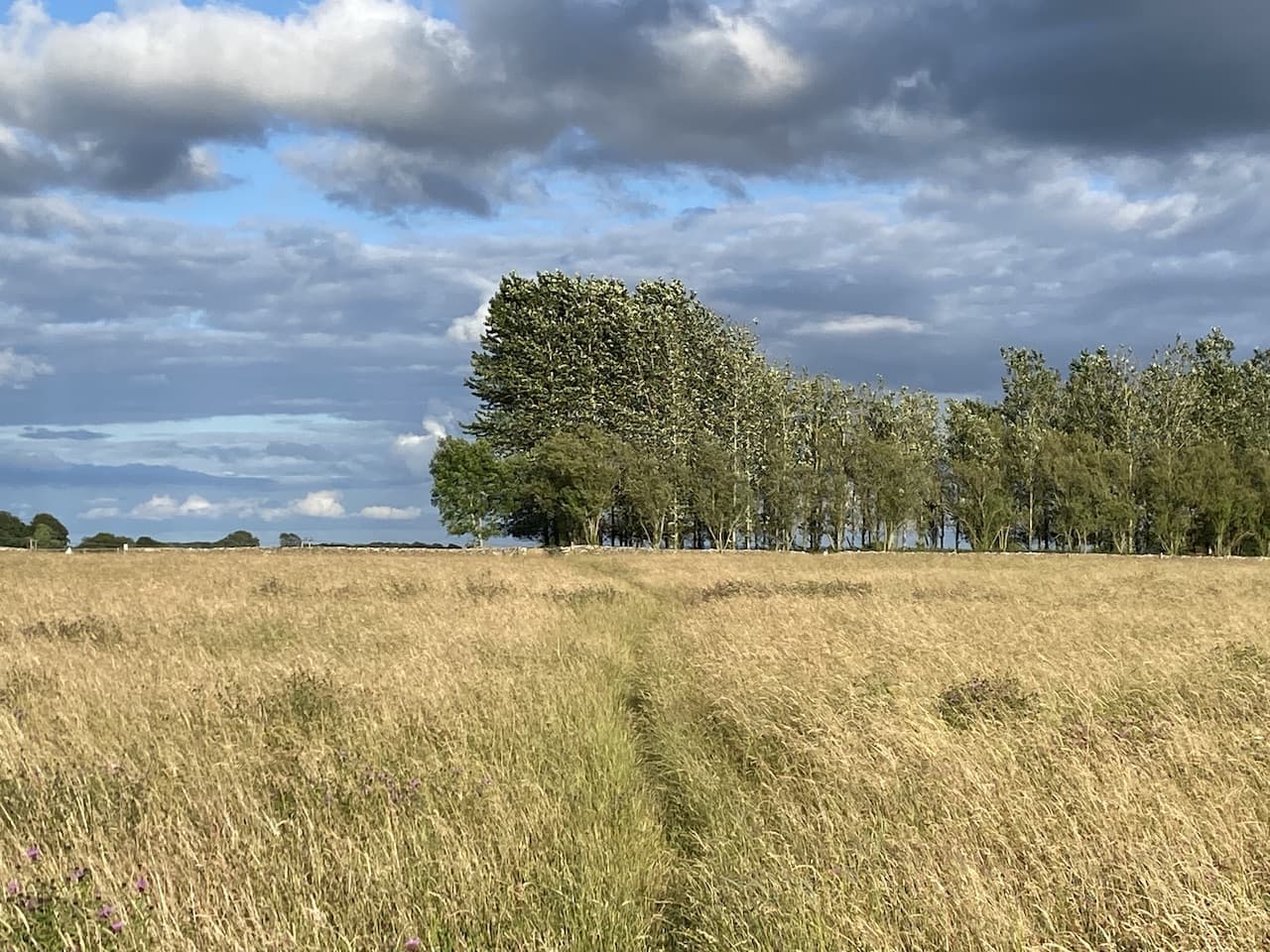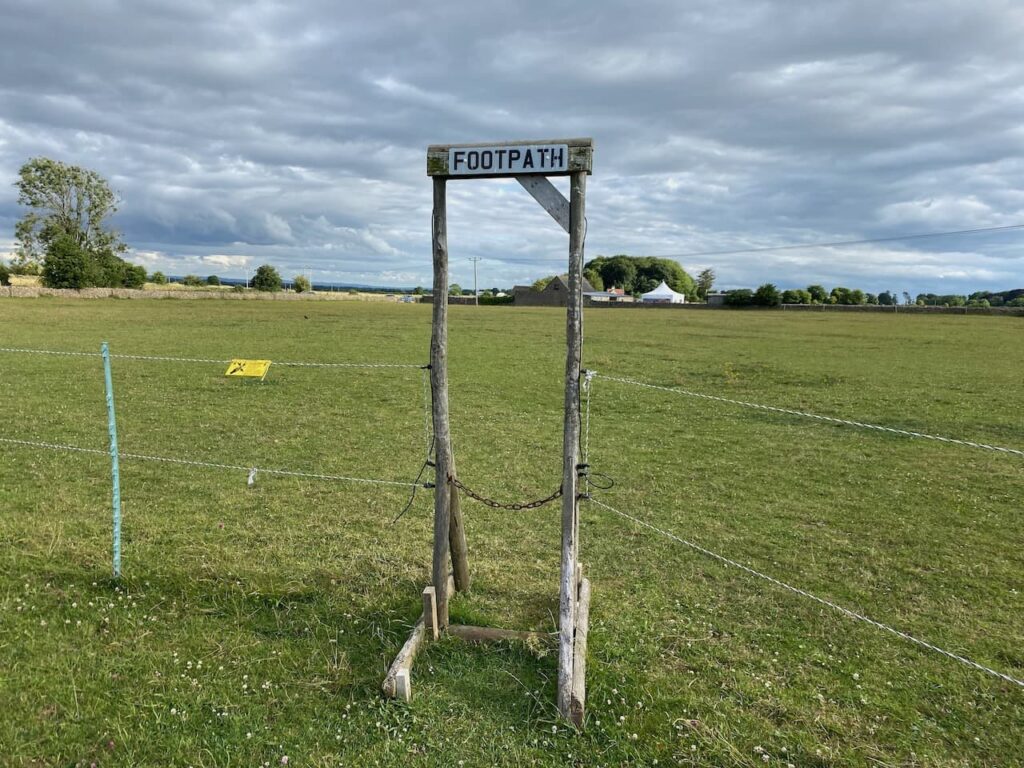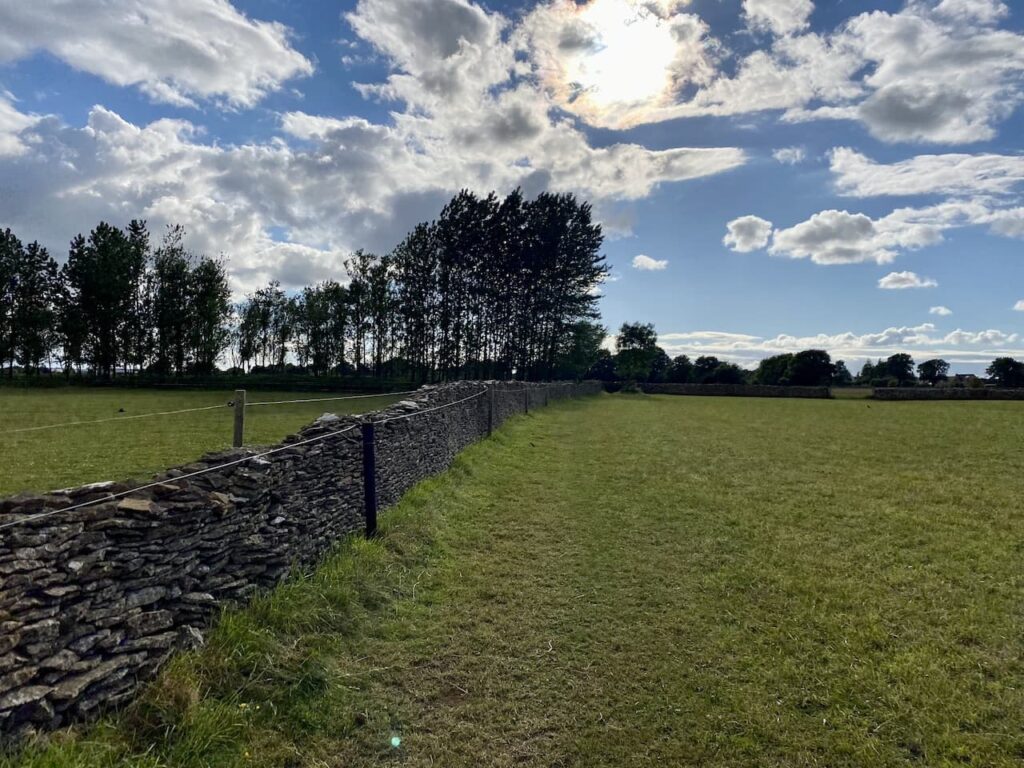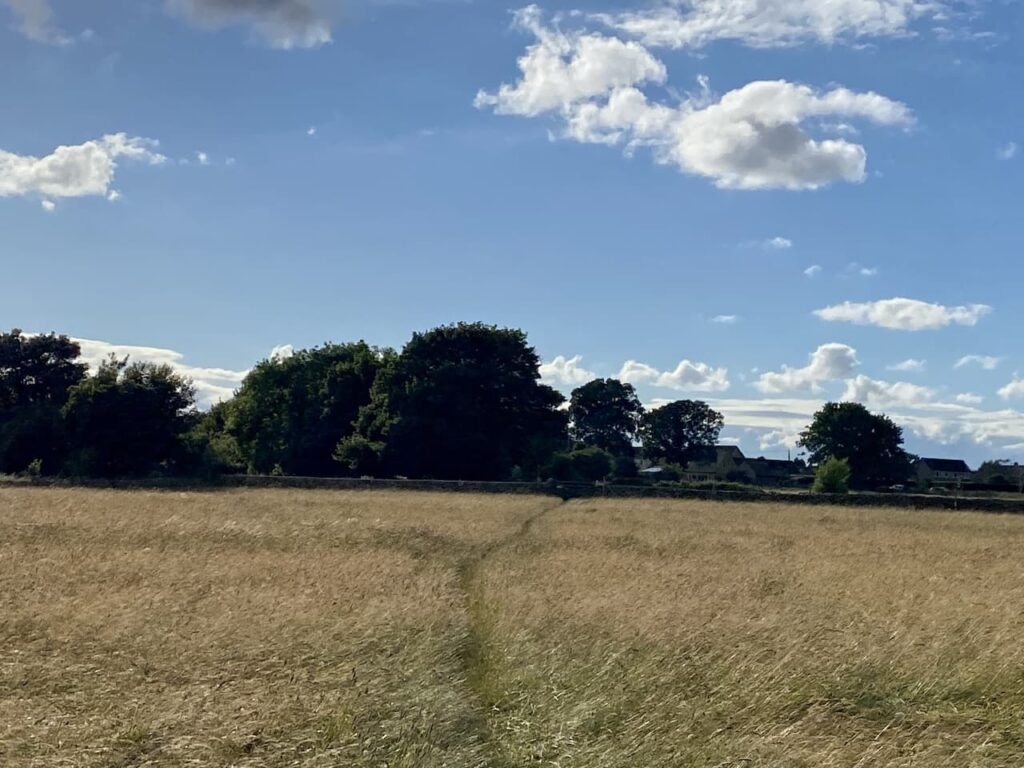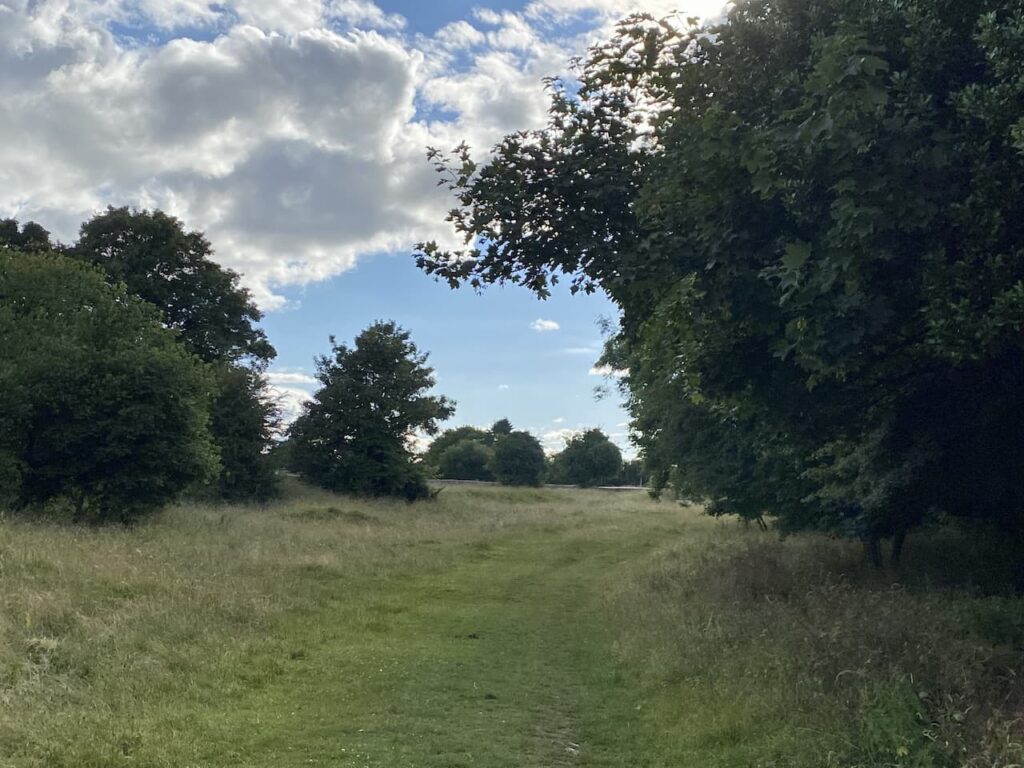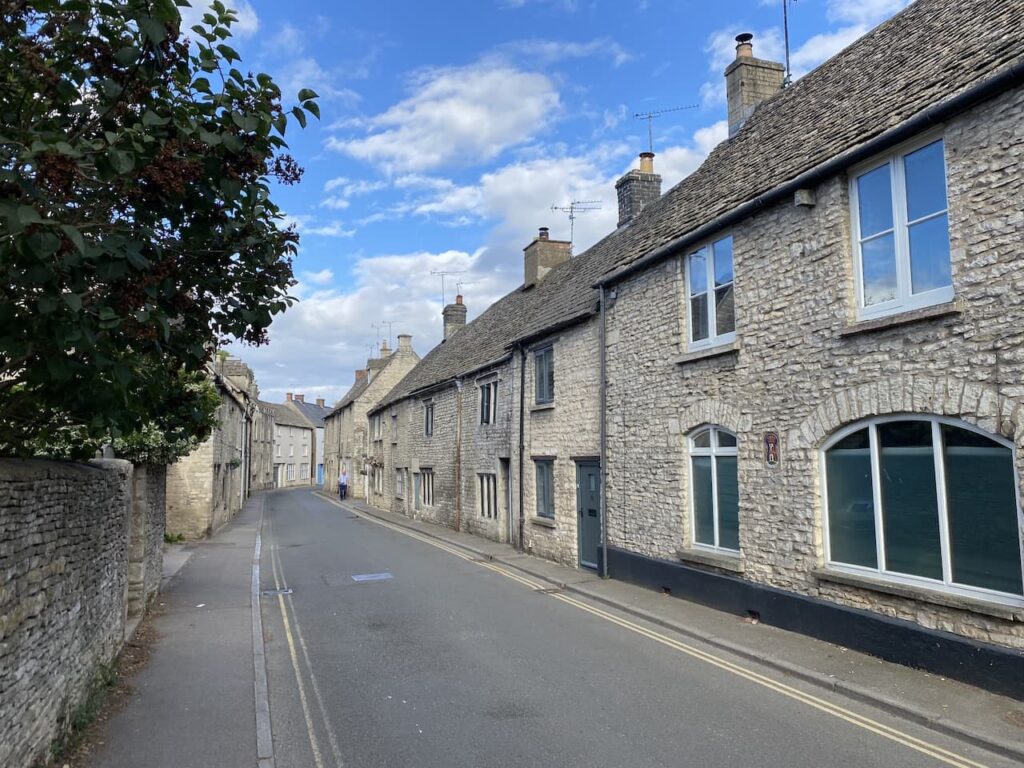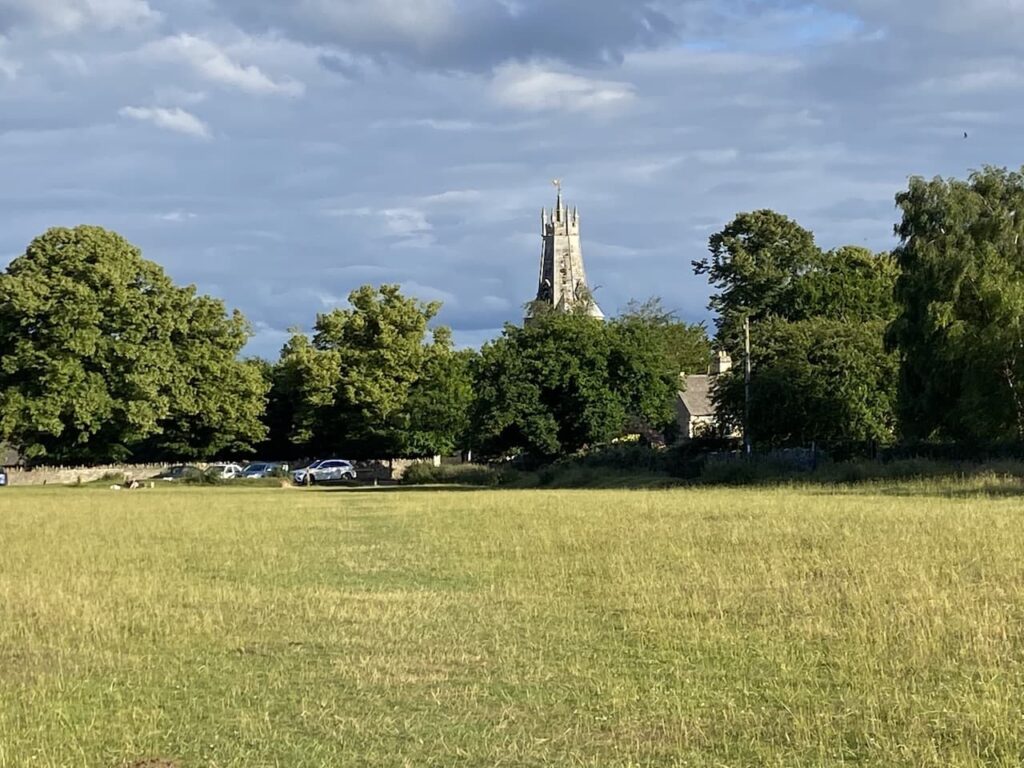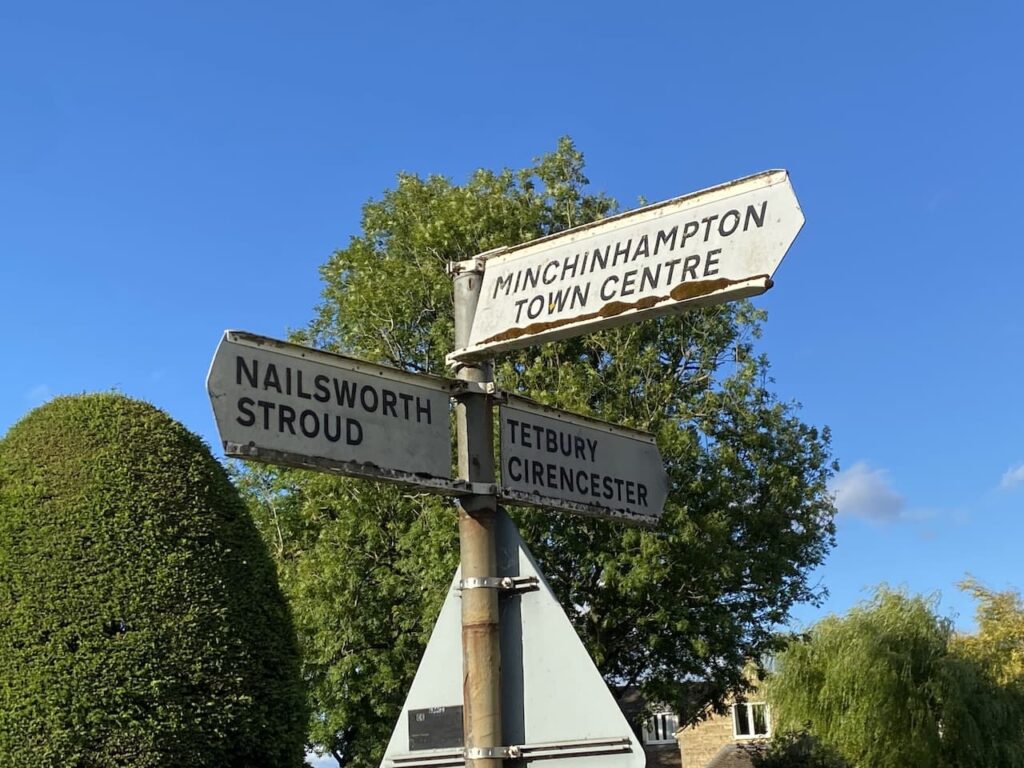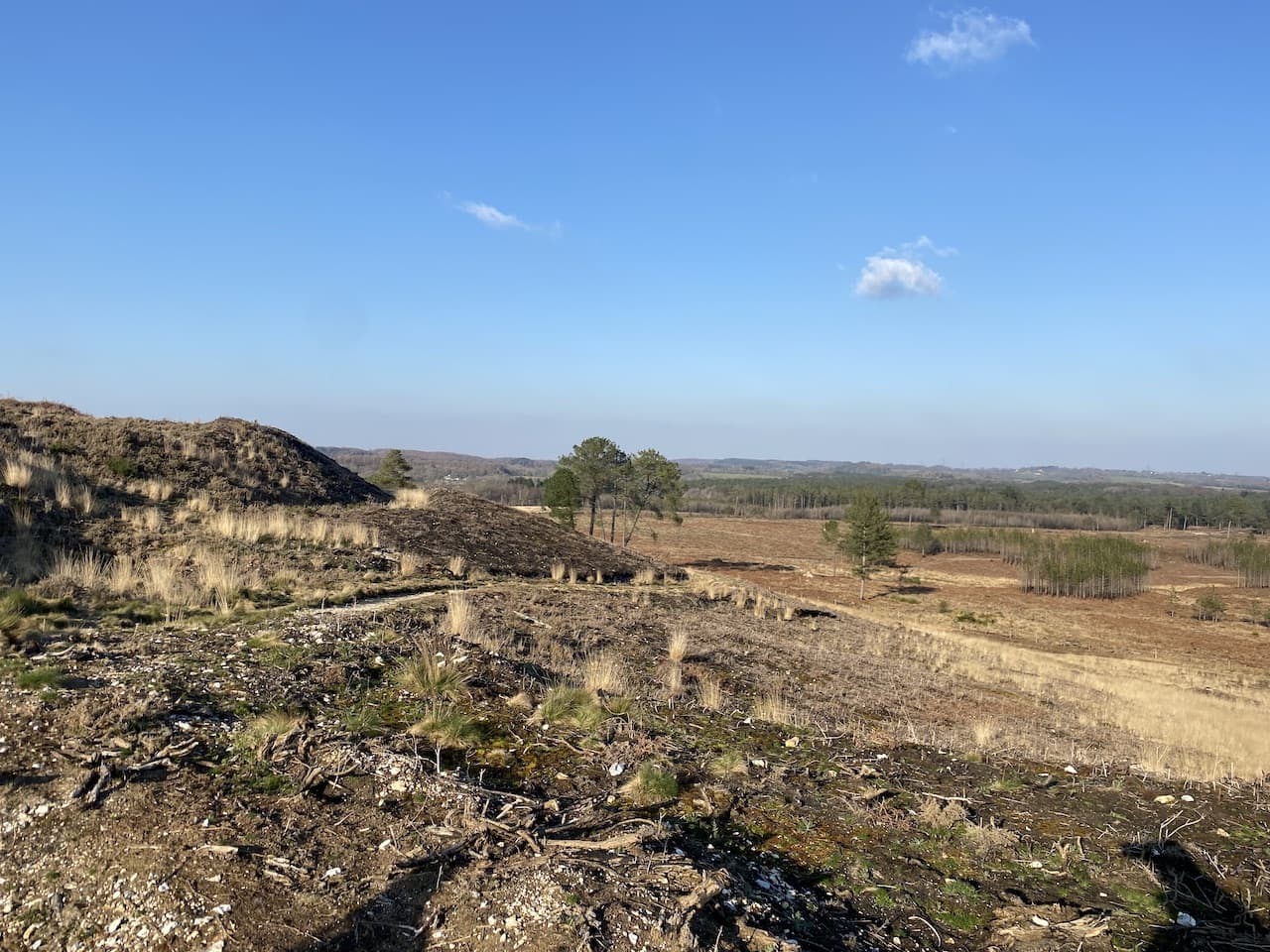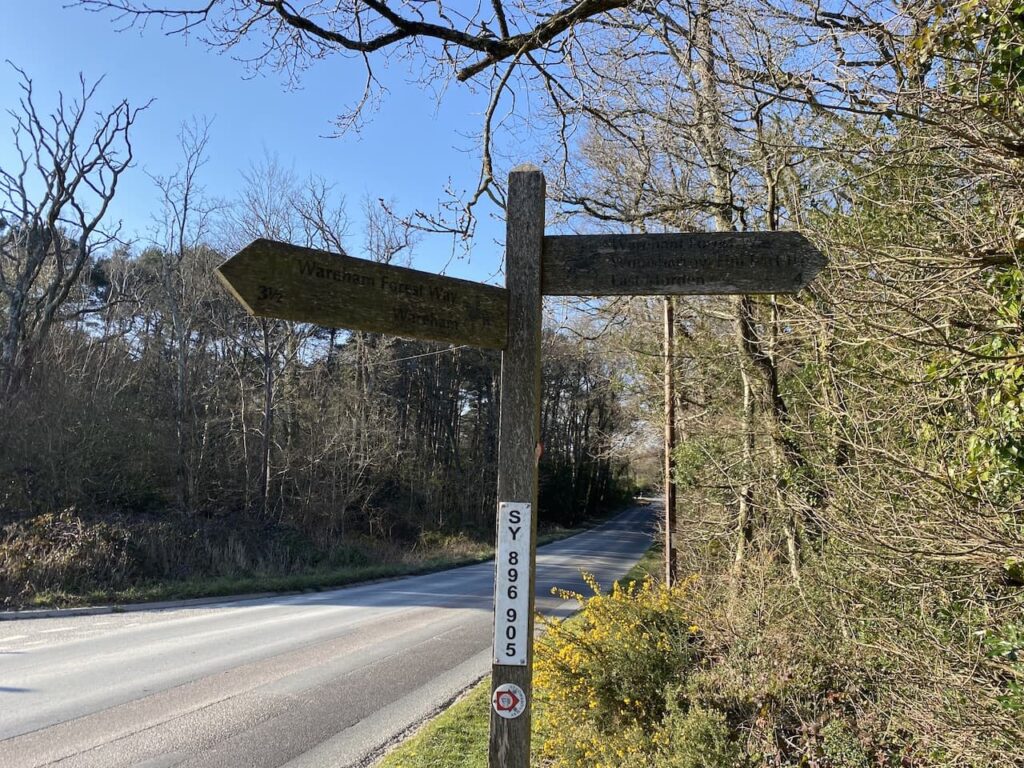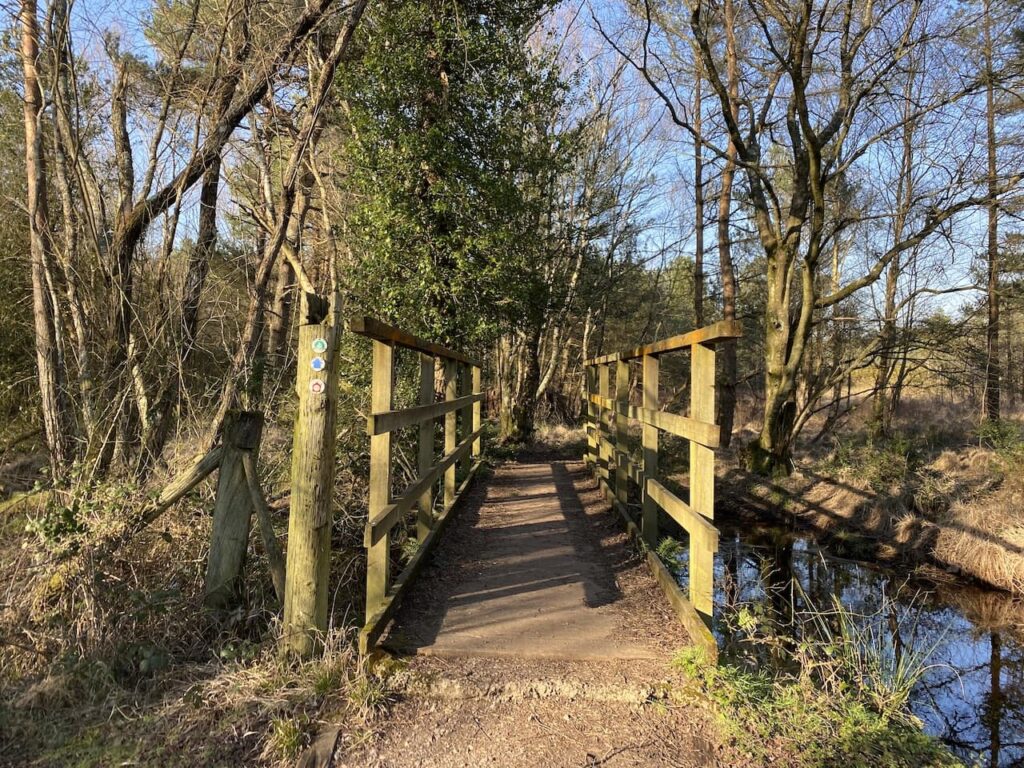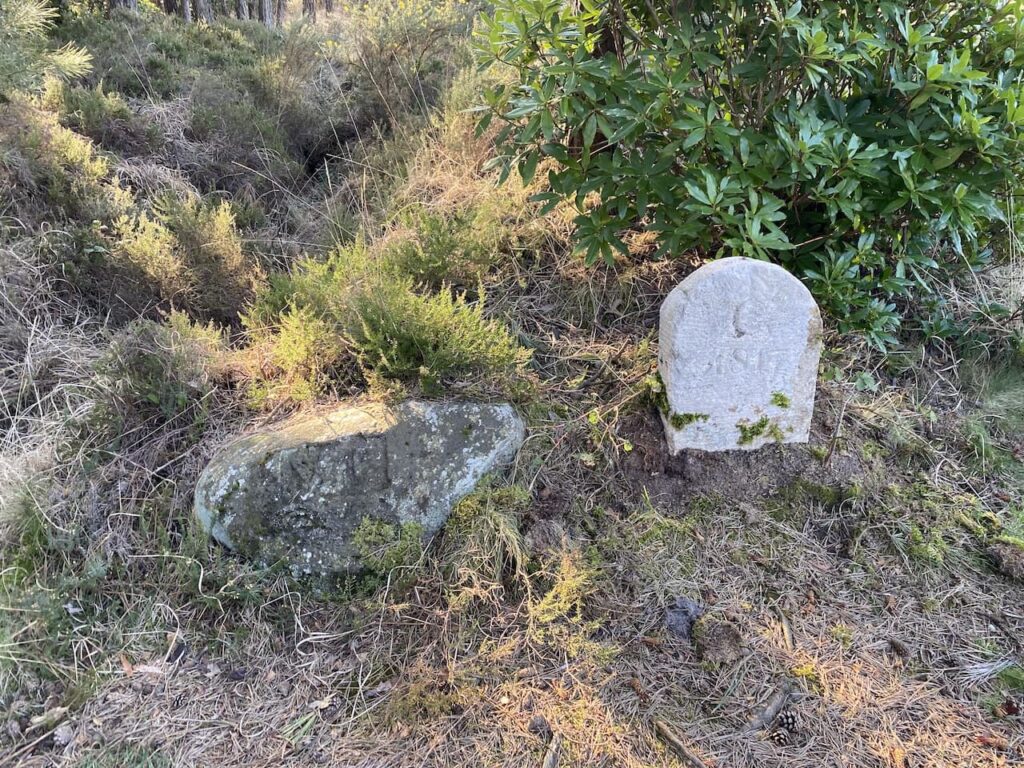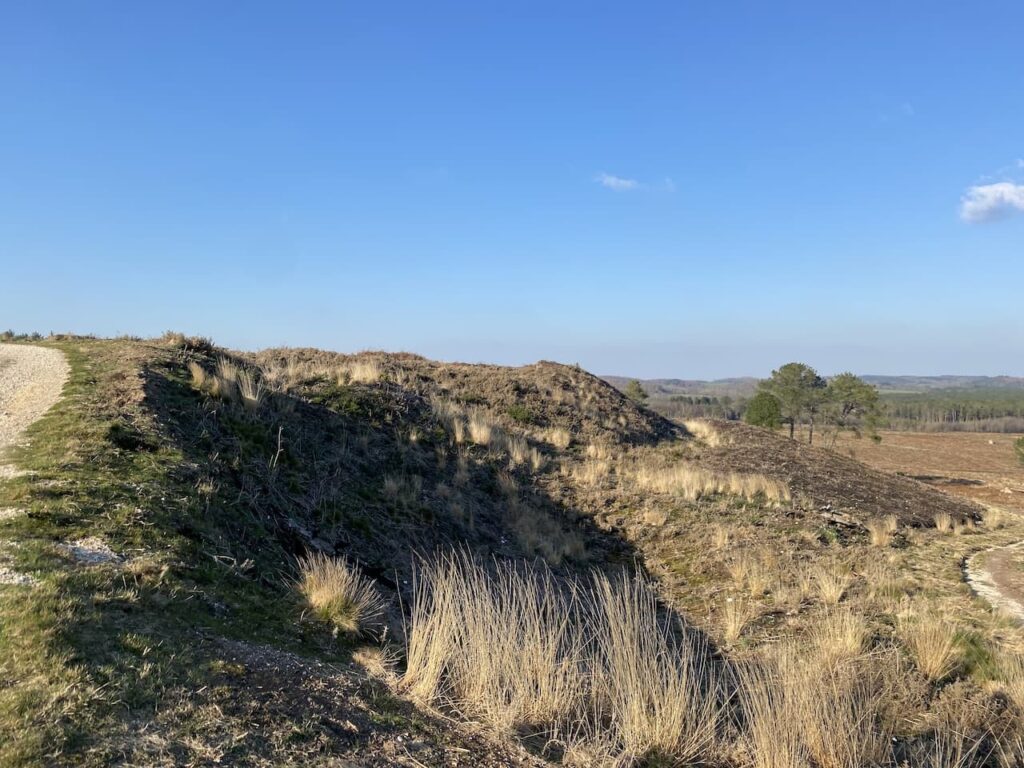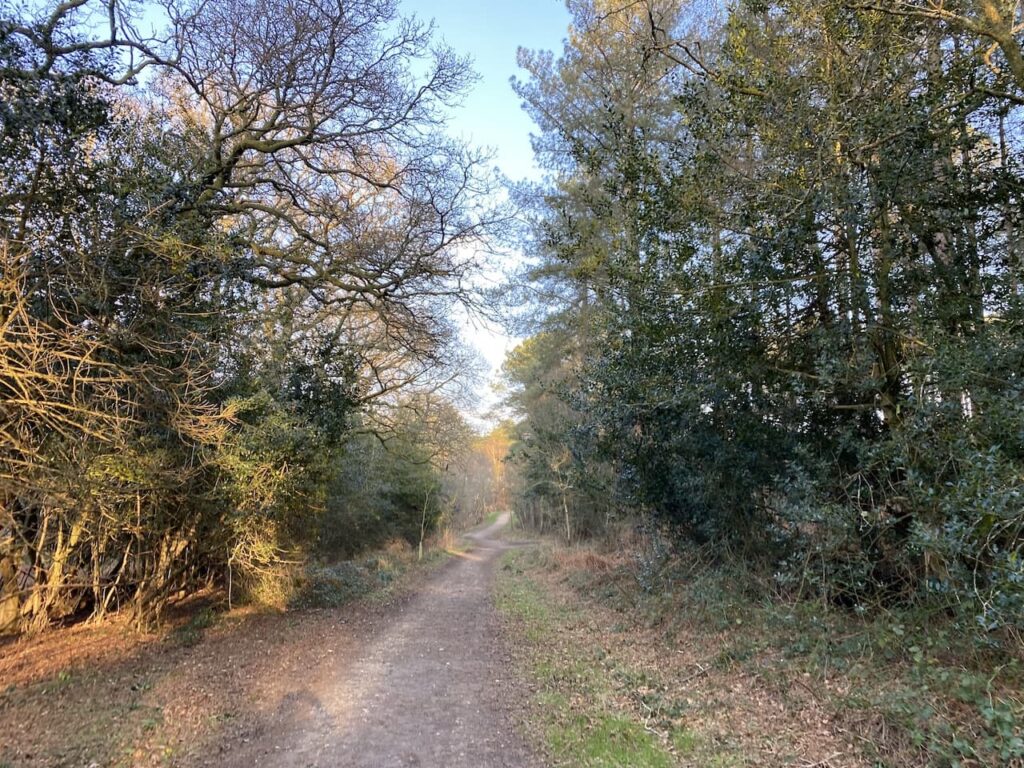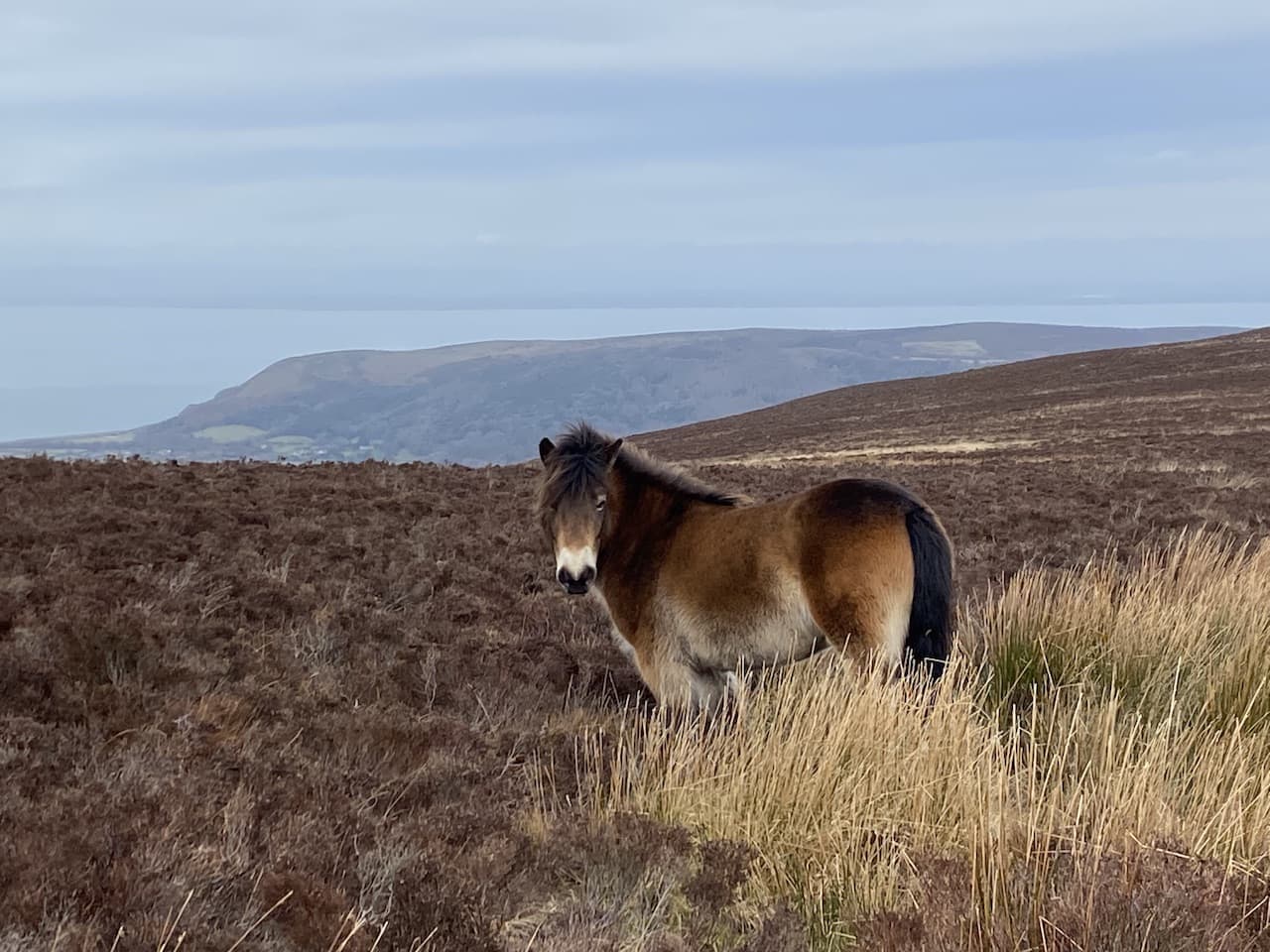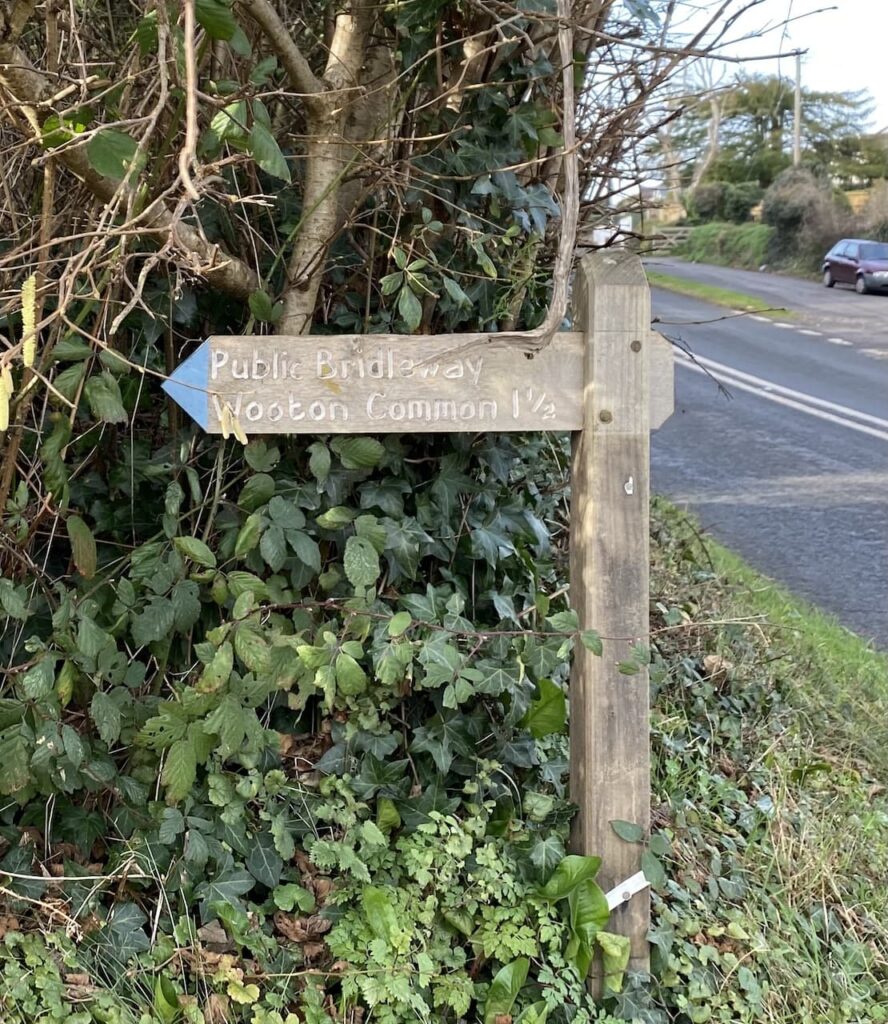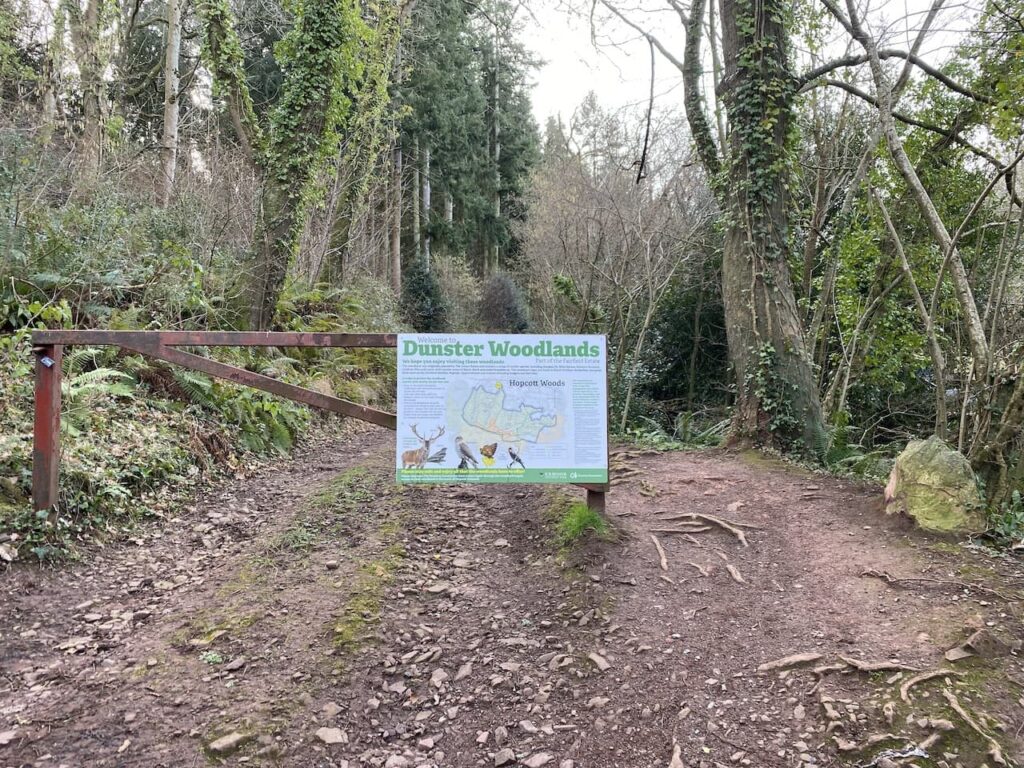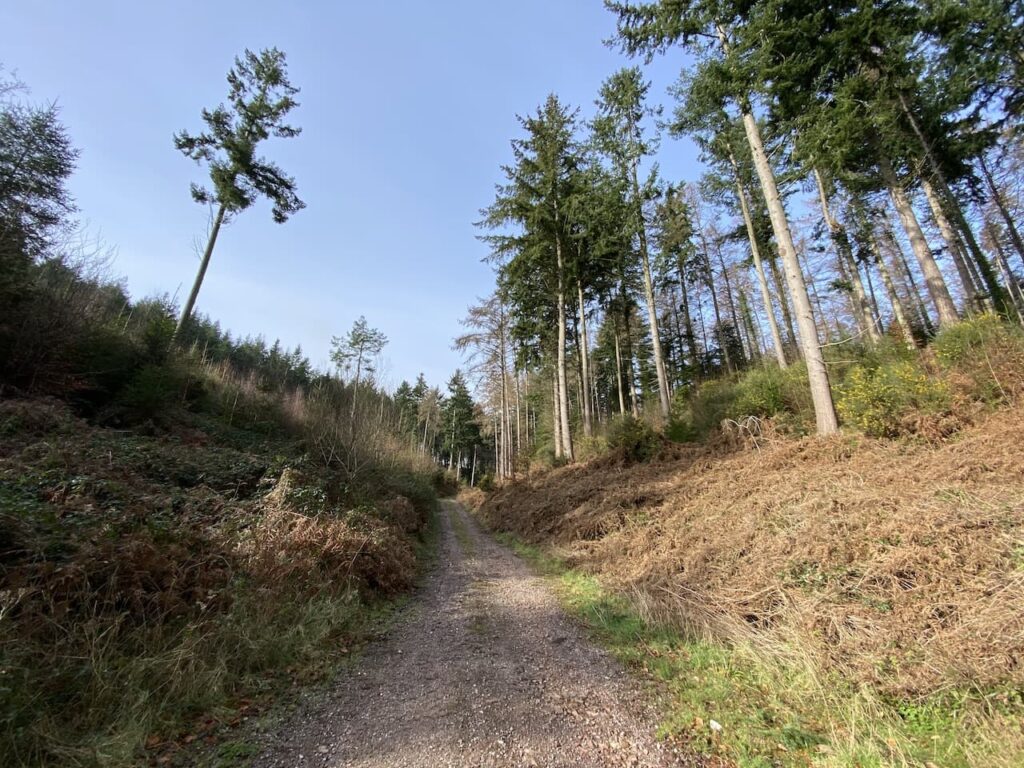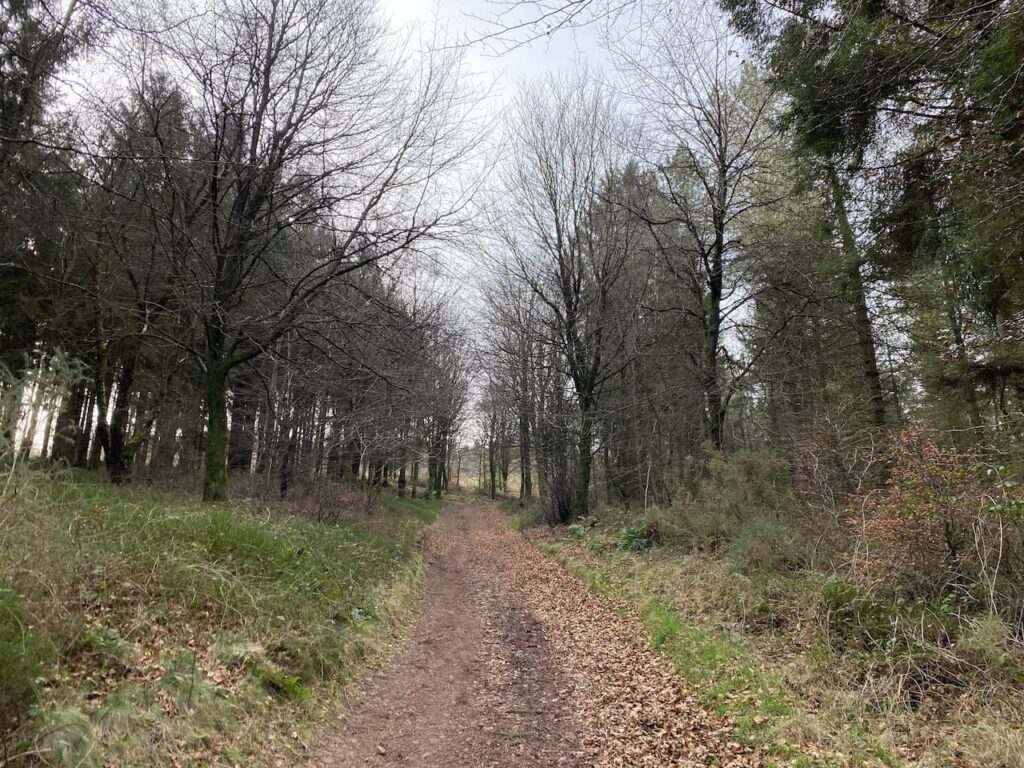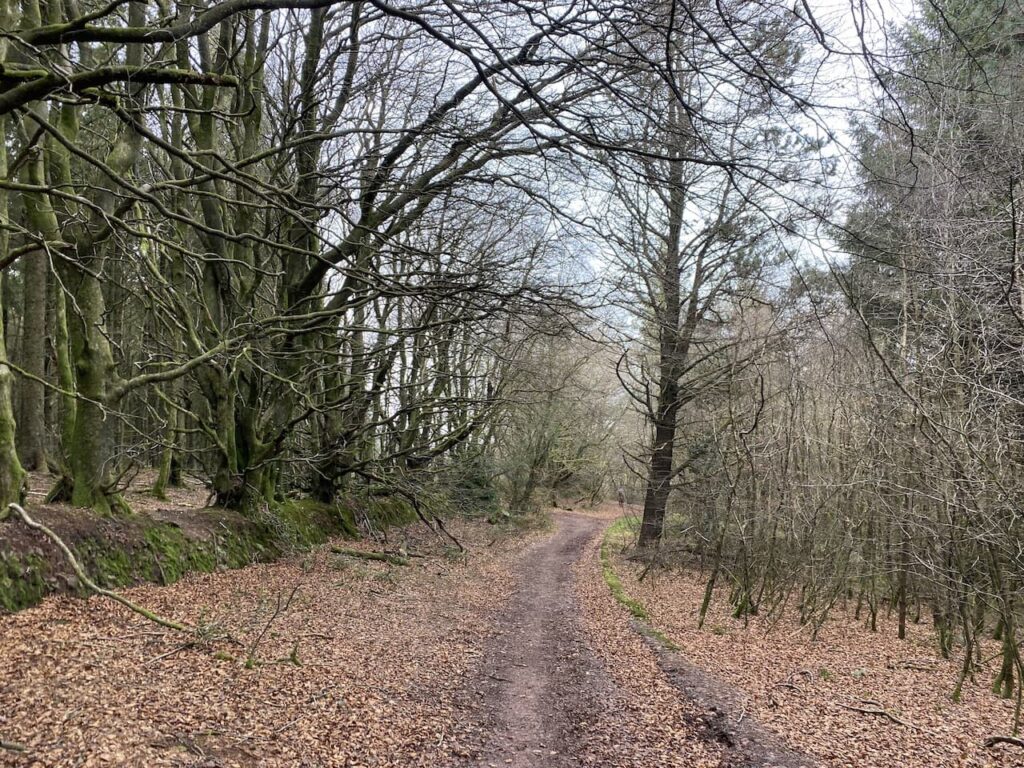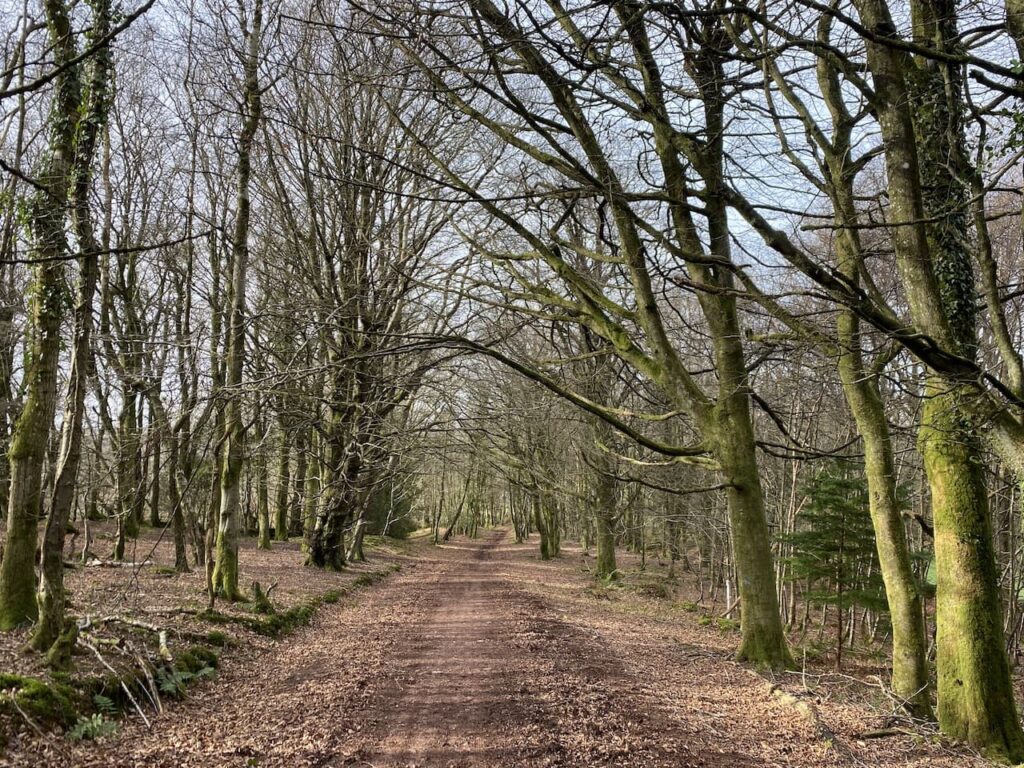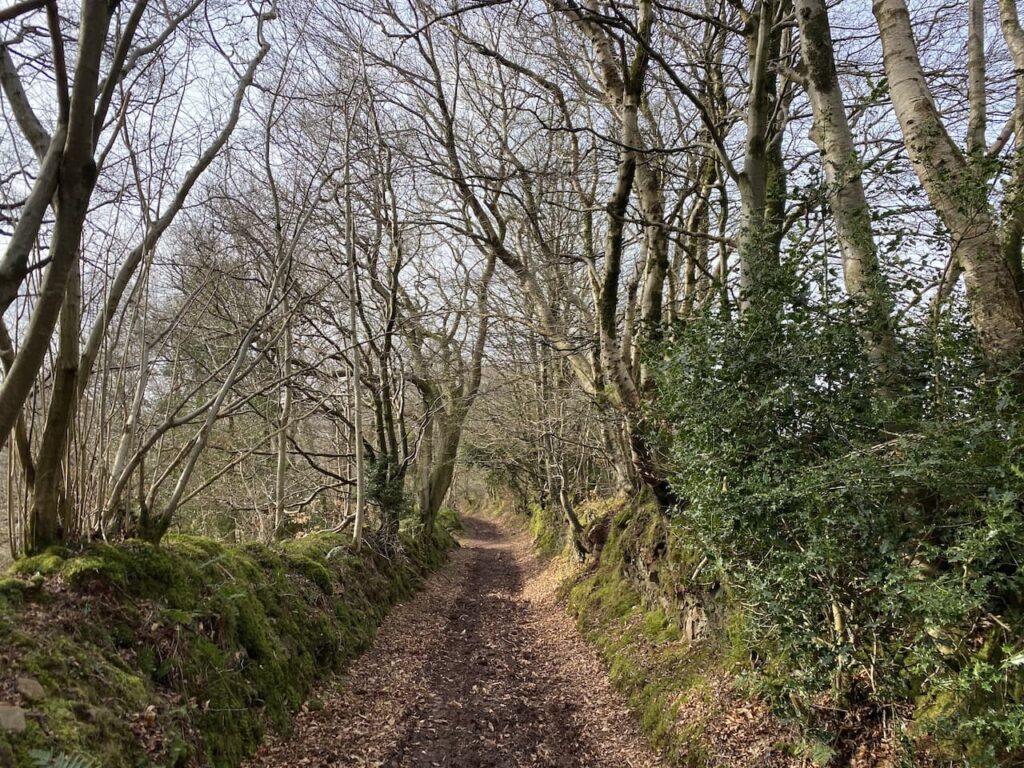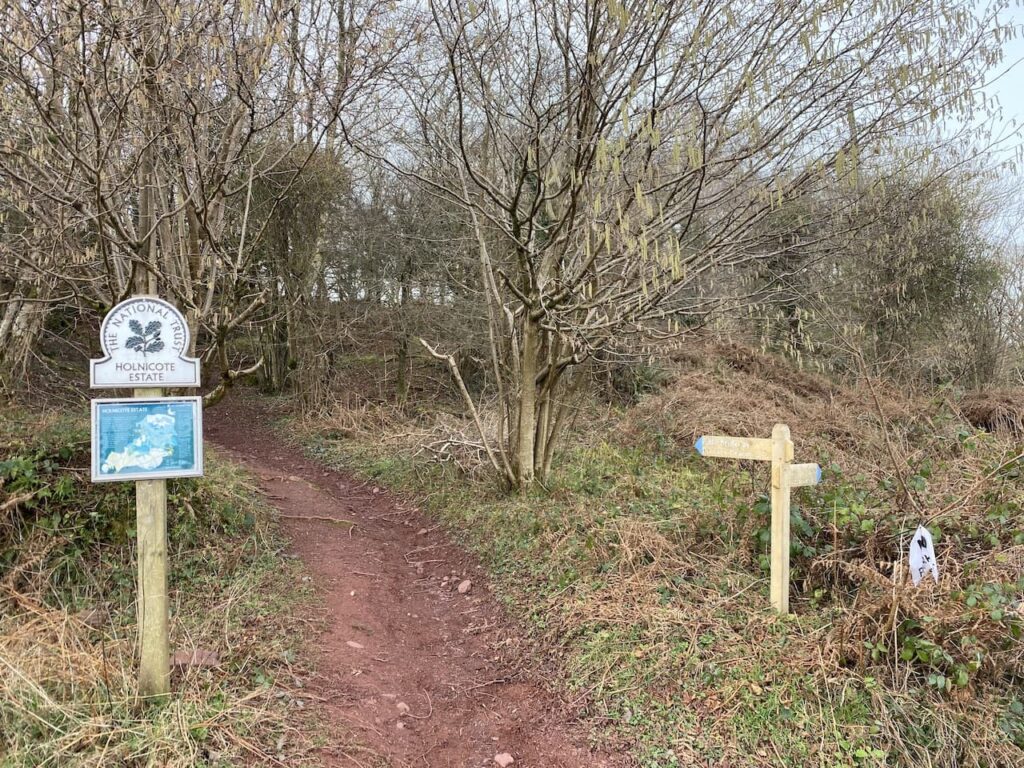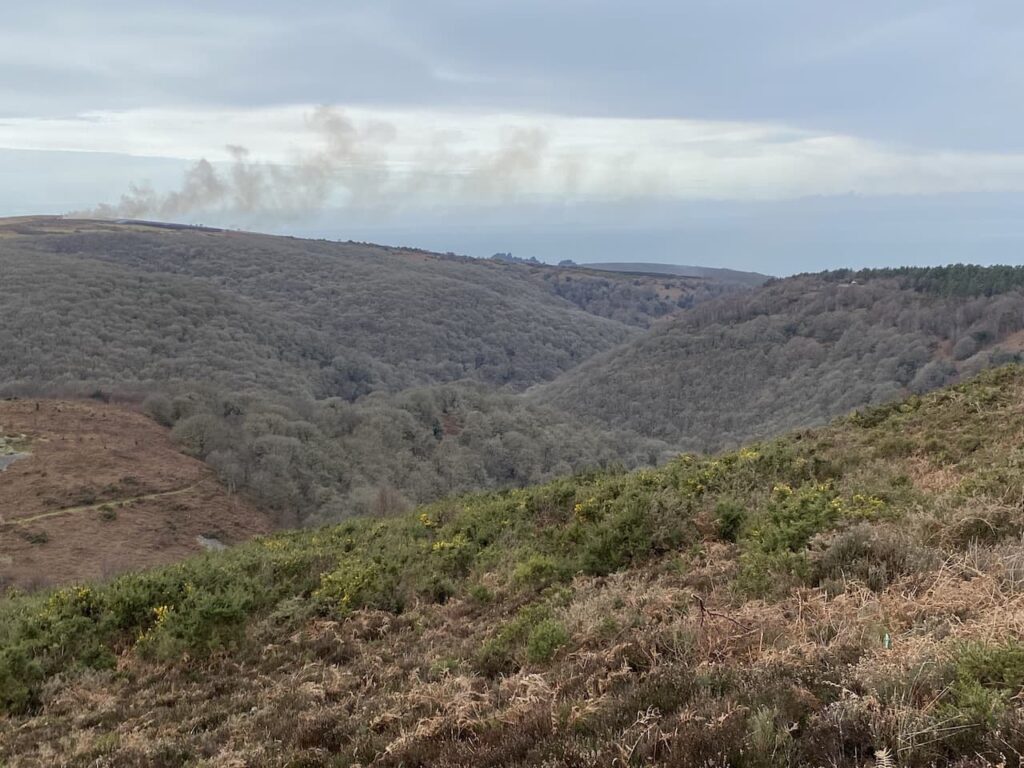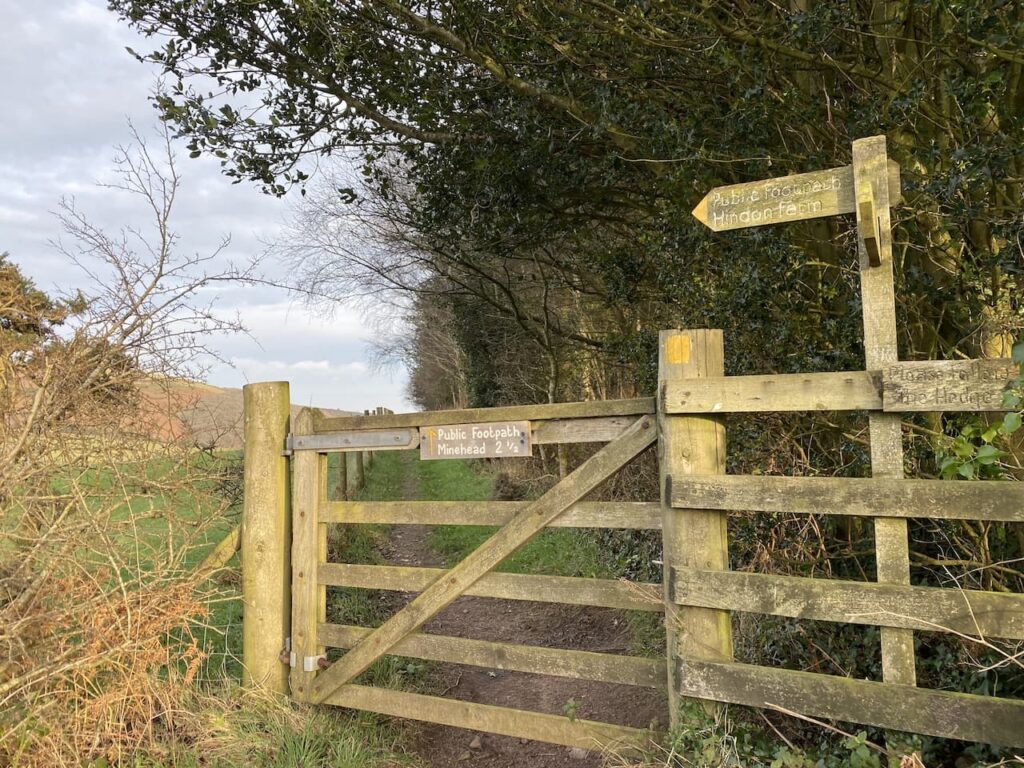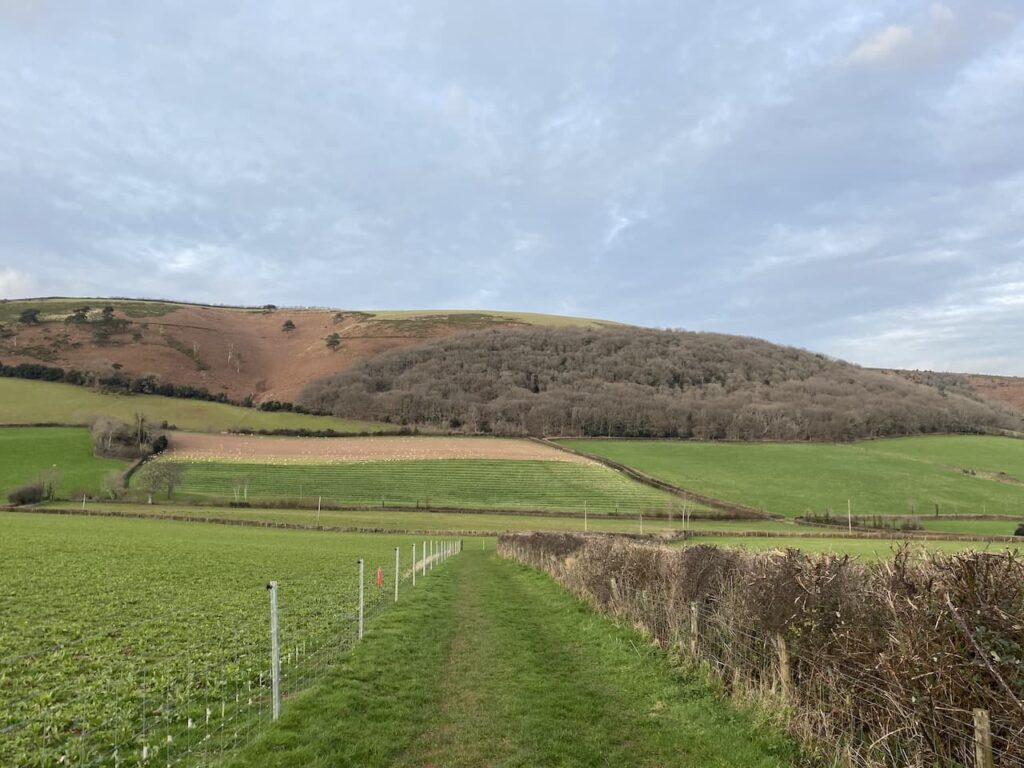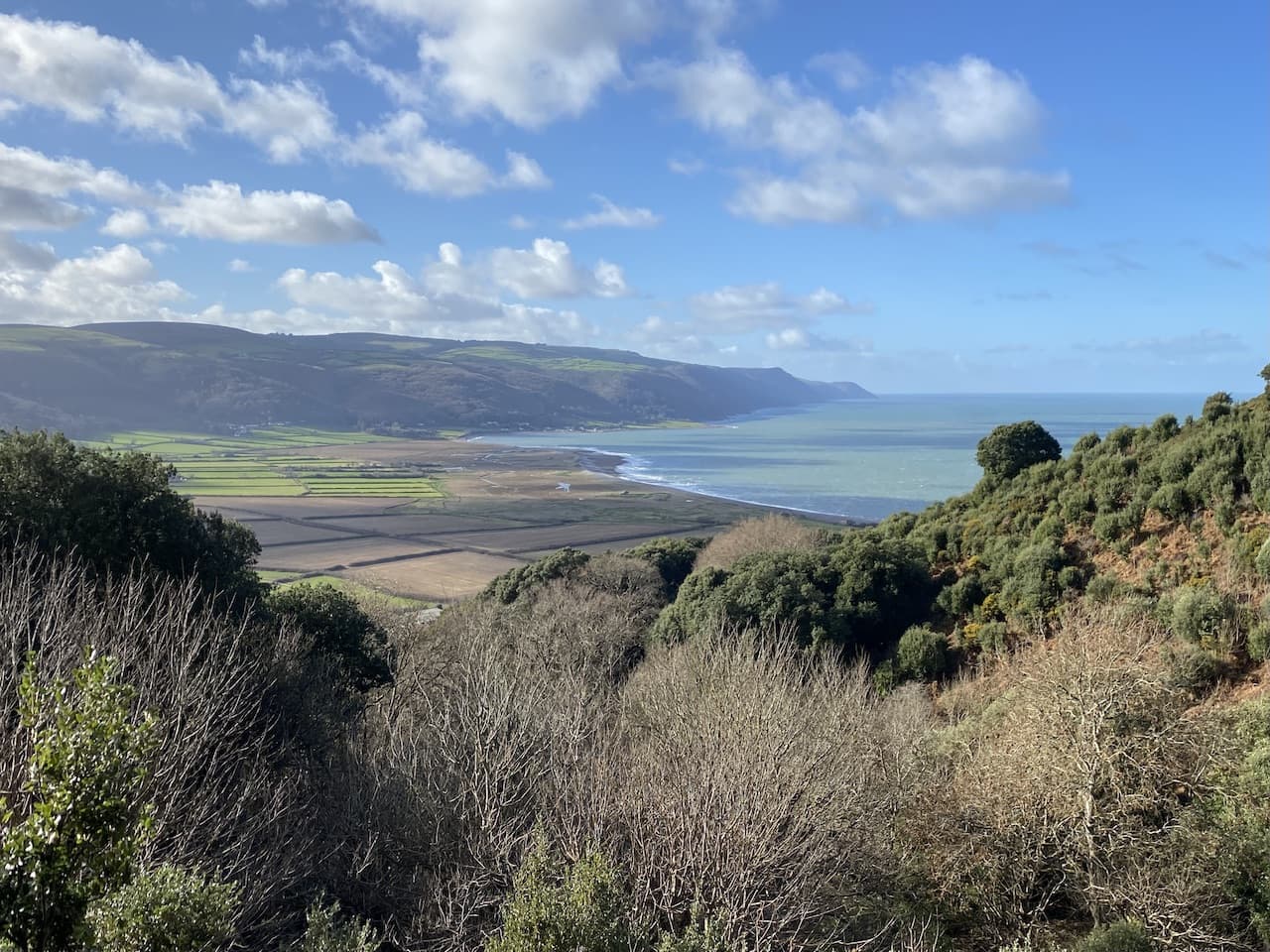After a couple of days walking from the caravan site I have decided it is time to get in the car to venture to a slightly different area. Today I plan to walk up to Dunkery Beacon, a hill I have walked many times. However, today I am going to ascend it on a path I have never walked.
The starting place for my walk is the National Trust car park in Horner (Grid Ref SS898455). I leave the car park by the path besides the pay and display machine and then join a minor road where I turn left soon passing Horner Mill, built around 1839. After passing the mill I take a footpath on the right which goes through tall deer gates.

This path follows a wide track uphill through Horner Plantation. I am on the route of the Coleridge Way, this long distance trail covers the fifty miles from Nether Stowey, on the east side of the Quantocks, to Lynmouth linking locations associated with the poet Samuel Taylor Coleridge.

At a junction of paths I turn right in the direction of Webber’s Post following the Coleridge Way markers, annotated with a writing quill.

Ignoring paths to the right and left I gradually ascend Horner Hill keeping with the route of the Coleridge Way. It is a cracking day and I soon get good views of Ley Hill on the opposite side of the combe.

This area is part of the Holnicote Estate, the Acland family seat for the best part of 300 years before Sir Richard Dyke Acland, 15th Baronet, donated both this and the Killerton Estate to the National Trust. The land covered 16,000 acres and was the largest donation received by the National Trust.
On top of Horner Hill there is a weather hut, thought to have been originally built by the Acland’s to celebrate Queen Victoria’s Diamond Jubilee, it became known as the Jubilee Hut. During World War II it was used as a look out post, but then fell into disrepair and collapsed in the winter of 1946. The National Trust have rebuilt it following the original design, facing four directions it always provides shelter from wind and rain.

I now continue along the Coleridge Way to reach Webber’s Post car park. Here the route goes in a south easterly direction to cross a minor road and then after going through a thicket reaches another minor road which I cross and go into another parking area. This is a bit of a sun trap and the Exmoor ponies appear to have chosen the spot for some winter warmth.

From the car park I follow the Coleridge Way as it goes uphill still heading south east.

At a junction of paths I turn left on the Coleridge Way heading towards Wooton Courtney. I have passed a couple of warning signs indicating there is gorse clearing work going on in the area. In front of me I can see smoke rising from the controlled fires.

The path goes close to the area being burnt, but the chaps supervising the fires make sure I can pass safely. One of them has a chat with me about the methods by which gorse is controlled in this area of the moor. It needs to be kept back otherwise it would smother everything and apparently an added bonus of fires is it regenerates the growth of heather.
The challenge for these chaps is knowing which way the wind will take the fire, apparently it has changed direction three times in the last forty minutes. Currently it is blowing from the east so as I continue along the path I know the smoke is blowing in the opposite direction.

Nearing woodland I take a path on the right and follow the contour line heading south. I soon reach the route of the Macmillan Way West. A right turn here would take me up towards Dunkery Beacon, but instead I turn left and descend a few yards to reach a path on the right. I have now rejoined the Coleridge Way and head steadily uphill.
There are a couple of paths leading off the route but I stay with the Coleridge Way and skirt round a field and then start going downhill.

I know if Lynnie was walking with me she would now be questioning the route and demanding why if we are walking up Dunkery Hill we are going downhill. Of course the answer to the question is to see where the path leads.

This path leads into Hanny Combe and it is a stunning spot.

I cross a stream and then it is a short steep ascent to reach a junction of paths. I go to the right to follow the Coleridge Way towards Spangate.

It is now a steady ascent towards Spangate with some stunning views behind me.

At a junction of paths at Spangate I leave the Coleridge Way and turn right to head uphill on a broad track which has intermittent boulders along it.

This is the first time I have approached Dunkery Beacon on this path. It is a long steady ascent to reach a minor road. After crossing I join a narrow path which heads west through the heather. In the distance on the horizon I can see Dunkery Beacon.

At a junction with a broader path I turn left and follow this route to reach the hill summit. This is the highest point on Exmoor and also the highest spot in Somerset. It stands at 1,705 feet and there is no protection from the elements so the wind is always blowing up here. Today there is a slight breeze but I have been up here when it is difficult to stay on your feet.

As I stand admiring the view I am approached by a lady who is interested in to know where I have walked from. She is bewildered by the distance I have walked so far and how much further I am going to travel. She has walked up from the road and says that was plenty enough for her. We then spend ten minutes talking about the spots we can see. She lives relatively nearby in Tiverton, but has never been up here before.
I have a choice of routes here, but decide to extend my walk by following a clear track heading west towards Little Rowbarrow.

The track passes by the ancient burial mound of Little Rowbarrow, On top of the barrow is a cairn which in poor weather would be a welcome site on this section of moor.

Soon I reach a junction of tracks where I turn right and pass Great Rowbarrow, this burial mound in more prominent and distinctive by the number of stones covering it.

The track now goes north west and soon starts to descend with Wilmersham Common in the distance.

At the road I turn right and follow this single track lane through Stoke Pero Common.

On reaching a small parking area I turn right on a track which follows the fence and tree line downhill into Bagley Combe.

The track leads down to a ford in Bagley Combe and then rises again and heads east towards Sweetworthy Combe.

At a fork in the track I go left and continue straight on at a junction of paths following a route which is shown on the map as Dicky’s Path. This soon heads through the attractive Aller Combe.

Now there is an open stretch of moorland before reaching trees to go through Hollow Combe after which the path heads north towards Easter Hill.

I ignore routes leading off this path and keep going north until I reach the car park at Webber’s Post. I now retrace my steps along the Coleridge Way until I reach the Memorial Hut where I take a path on the left descending steeply through Horner Side.

The route zig-zags its way down the hill, I ignore paths from it to reach a footbridge over Horner Water.

After crossing the footbridge I turn right and follow a wide track with the attractive Horner Water flowing to my right.

I stay with this path heading towards Horner. After crossing a stone bridge I turn left along the road and walk through the hamlet to reach the entrance to the car park.

My walk has covered almost 13 miles. The sun shone for most of the day and it has felt more like a spring day than early February. I have been very lucky with the weather this week. Let’s hope it lasts into tomorrow because that will be my last chance to be out on the moor for a while.
You can view this 12.6 mile walk on OS Maps and download the GPX File Here
To follow my walk, you will need Ordnance Survey Explorer Map OL9 – Exmoor
8th February 2023
© Two Dogs and an Awning (2023)
All information on this site is provided free of charge and in good faith and no liability is accepted in respect of damage, loss or injury which might result from it. To the best of my knowledge the routes are entirely on public rights of way or within areas that are open for public access.
Walking can be hazardous and is done entirely at your own risk. It is your responsibility to check your route and navigate using a map and compass.
